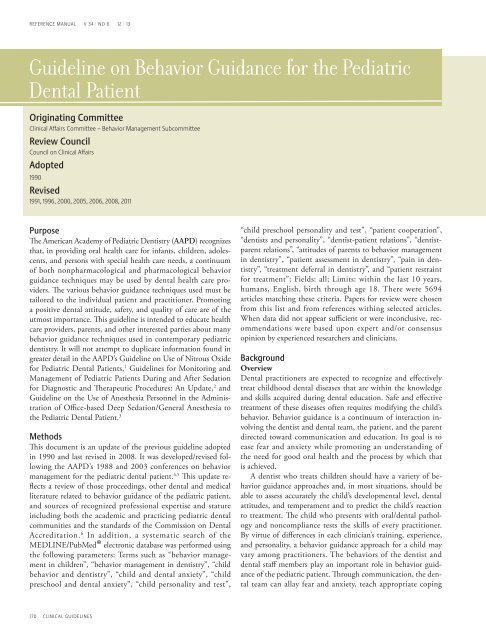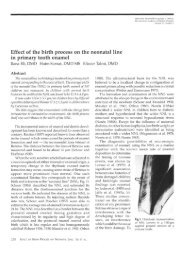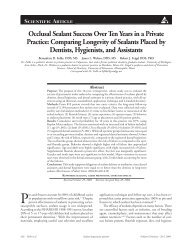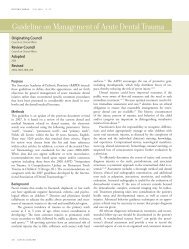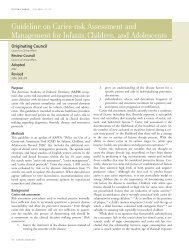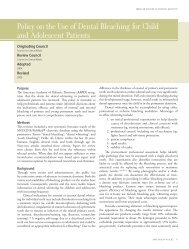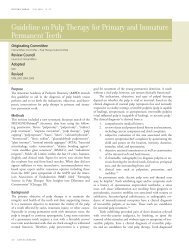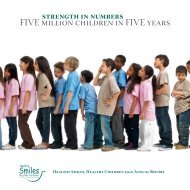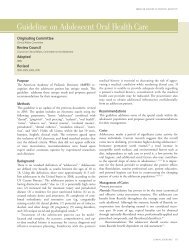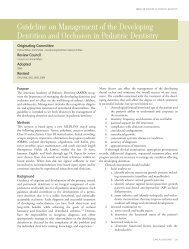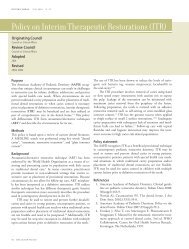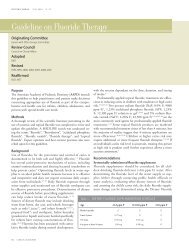Guideline on Behavior Guidance for the Pediatric Dental Patient
Guideline on Behavior Guidance for the Pediatric Dental Patient
Guideline on Behavior Guidance for the Pediatric Dental Patient
Create successful ePaper yourself
Turn your PDF publications into a flip-book with our unique Google optimized e-Paper software.
REFERENCE MANUAL V 34 / NO 6 12 / 13<br />
<str<strong>on</strong>g>Guideline</str<strong>on</strong>g> <strong>on</strong> <strong>Behavior</strong> <strong>Guidance</strong> <strong>for</strong> <strong>the</strong> <strong>Pediatric</strong><br />
<strong>Dental</strong> <strong>Patient</strong><br />
Originating Committee<br />
Clinical Affairs Committee – <strong>Behavior</strong> Management Subcommittee<br />
Review Council<br />
Council <strong>on</strong> Clinical Affairs<br />
Adopted<br />
1990<br />
Revised<br />
1991, 1996, 2000, 2005, 2006, 2008, 2011<br />
Purpose<br />
The American Academy of <strong>Pediatric</strong> Dentistry (AAPD) recognizes<br />
that, in providing oral health care <strong>for</strong> infants, children, adolescents,<br />
and pers<strong>on</strong>s with special health care needs, a c<strong>on</strong>tinuum<br />
of both n<strong>on</strong>pharmacological and pharmacological behavior<br />
guidance techniques may be used by dental health care pro-<br />
viders. The various behavior guidance techniques used must be<br />
tailored to <strong>the</strong> individual patient and practiti<strong>on</strong>er. Promoting<br />
a positive dental attitude, safety, and quality of care are of <strong>the</strong><br />
utmost importance. This guideline is intended to educate health<br />
care providers, parents, and o<strong>the</strong>r interested parties about many<br />
behavior guidance techniques used in c<strong>on</strong>temporary pediatric<br />
dentistry. It will not attempt to duplicate in<strong>for</strong>mati<strong>on</strong> found in<br />
greater detail in <strong>the</strong> AAPD’s <str<strong>on</strong>g>Guideline</str<strong>on</strong>g> <strong>on</strong> Use of Nitrous Oxide<br />
<strong>for</strong> <strong>Pediatric</strong> <strong>Dental</strong> <strong>Patient</strong>s, 1 <str<strong>on</strong>g>Guideline</str<strong>on</strong>g>s <strong>for</strong> M<strong>on</strong>itoring and<br />
Management of <strong>Pediatric</strong> <strong>Patient</strong>s During and After Sedati<strong>on</strong><br />
<strong>for</strong> Diagnostic and Therapeutic Procedures: An Update, 2 and<br />
<str<strong>on</strong>g>Guideline</str<strong>on</strong>g> <strong>on</strong> <strong>the</strong> Use of Anes<strong>the</strong>sia Pers<strong>on</strong>nel in <strong>the</strong> Administrati<strong>on</strong><br />
of Office-based Deep Sedati<strong>on</strong>/General Anes<strong>the</strong>sia to<br />
<strong>the</strong> <strong>Pediatric</strong> <strong>Dental</strong> <strong>Patient</strong>. 3<br />
Methods<br />
This document is an update of <strong>the</strong> previous guideline adopted<br />
in 1990 and last revised in 2008. It was developed/revised following<br />
<strong>the</strong> AAPD’s 1988 and 2003 c<strong>on</strong>ferences <strong>on</strong> behavior<br />
management <strong>for</strong> <strong>the</strong> pediatric dental patient. 4,5 This update reflects<br />
a review of those proceedings, o<strong>the</strong>r dental and medical<br />
literature related to behavior guidance of <strong>the</strong> pediatric patient,<br />
and sources of recognized professi<strong>on</strong>al expertise and stature<br />
including both <strong>the</strong> academic and practicing pediatric dental<br />
communities and <strong>the</strong> standards of <strong>the</strong> Commissi<strong>on</strong> <strong>on</strong> <strong>Dental</strong><br />
Accreditati<strong>on</strong>. 6 In additi<strong>on</strong>, a systematic search of <strong>the</strong><br />
MEDLINE/PubMed® electr<strong>on</strong>ic database was per<strong>for</strong>med using<br />
<strong>the</strong> following parameters: Terms such as “behavior management<br />
in children”, “behavior management in dentistry”, “child<br />
behavior and dentistry”, “child and dental anxiety”, “child<br />
preschool and dental anxiety”, “child pers<strong>on</strong>ality and test”,<br />
170 CLINICAL GUIDELINES<br />
“child preschool pers<strong>on</strong>ality and test”, “patient cooperati<strong>on</strong>”,<br />
“dentists and pers<strong>on</strong>ality”, “dentist-patient relati<strong>on</strong>s”, “dentistparent<br />
relati<strong>on</strong>s”, “attitudes of parents to behavior management<br />
in dentistry”, “patient assessment in dentistry”, “pain in den-<br />
tistry”, “treatment deferral in dentistry”, and “patient restraint<br />
<strong>for</strong> treatment”; Fields: all; Limits: within <strong>the</strong> last 10 years,<br />
humans, English, birth through age 18. There were 5694<br />
articles matching <strong>the</strong>se criteria. Papers <strong>for</strong> review were chosen<br />
from this list and from references withing selected articles.<br />
When data did not appear sufficient or were inc<strong>on</strong>clusive, rec-<br />
ommendati<strong>on</strong>s were based up<strong>on</strong> expert and/or c<strong>on</strong>sensus<br />
opini<strong>on</strong> by experienced researchers and clinicians.<br />
Background<br />
Overview<br />
<strong>Dental</strong> practiti<strong>on</strong>ers are expected to recognize and effectively<br />
treat childhood dental diseases that are within <strong>the</strong> knowledge<br />
and skills acquired during dental educati<strong>on</strong>. Safe and effective<br />
treatment of <strong>the</strong>se diseases often requires modifying <strong>the</strong> child’s<br />
behavior. <strong>Behavior</strong> guidance is a c<strong>on</strong>tinuum of interacti<strong>on</strong> involving<br />
<strong>the</strong> dentist and dental team, <strong>the</strong> patient, and <strong>the</strong> parent<br />
directed toward communicati<strong>on</strong> and educati<strong>on</strong>. Its goal is to<br />
ease fear and anxiety while promoting an understanding of<br />
<strong>the</strong> need <strong>for</strong> good oral health and <strong>the</strong> process by which that<br />
is achieved.<br />
A dentist who treats children should have a variety of be-<br />
havior guidance approaches and, in most situati<strong>on</strong>s, should be<br />
able to assess accurately <strong>the</strong> child’s developmental level, dental<br />
attitudes, and temperament and to predict <strong>the</strong> child’s reacti<strong>on</strong><br />
to treatment. The child who presents with oral/dental pathology<br />
and n<strong>on</strong>compliance tests <strong>the</strong> skills of every practiti<strong>on</strong>er.<br />
By virtue of differences in each clinician’s training, experience,<br />
and pers<strong>on</strong>ality, a behavior guidance approach <strong>for</strong> a child may<br />
vary am<strong>on</strong>g practiti<strong>on</strong>ers. The behaviors of <strong>the</strong> dentist and<br />
dental staff members play an important role in behavior guid-<br />
ance of <strong>the</strong> pediatric patient. Through communicati<strong>on</strong>, <strong>the</strong> den-<br />
tal team can allay fear and anxiety, teach appropriate coping
mechanisms, and guide <strong>the</strong> child to be cooperative, relaxed,<br />
and self-c<strong>on</strong>fident in <strong>the</strong> dental setting. Successful behavior<br />
guidance enables <strong>the</strong> oral health team to per<strong>for</strong>m quality treat-<br />
ment safely and efficiently and to nurture a positive dental<br />
attitude in <strong>the</strong> child.<br />
Some of <strong>the</strong> behavior guidance techniques in this document<br />
are intended to maintain communicati<strong>on</strong>, while o<strong>the</strong>rs<br />
are intended to extinguish inappropriate behavior and establish<br />
communicati<strong>on</strong>. As such, <strong>the</strong>se techniques cannot be evaluated<br />
<strong>on</strong> an individual basis as to validity, but must be assessed within<br />
<strong>the</strong> c<strong>on</strong>text of <strong>the</strong> child’s total dental experience. Each techni-<br />
que must be integrated into an overall behavior guidance<br />
approach individualized <strong>for</strong> each child. There<strong>for</strong>e, behavior<br />
guidance is as much an art as it is a science. It is not an appli-<br />
cati<strong>on</strong> of individual techniques created to “deal” with children,<br />
but ra<strong>the</strong>r a comprehensive, c<strong>on</strong>tinuous method meant to<br />
develop and nurture <strong>the</strong> relati<strong>on</strong>ship between patient and doc-<br />
tor, which ultimately builds trust and allays fear and anxiety.<br />
This guideline c<strong>on</strong>tains definiti<strong>on</strong>s, objectives, indicati<strong>on</strong>s,<br />
and c<strong>on</strong>traindicati<strong>on</strong>s <strong>for</strong> behavior guidance techniques<br />
comm<strong>on</strong>ly taught and used in pediatric dentistry. 6-11 This docu-<br />
ment is reflective of <strong>the</strong> AAPD’s role as an advocate <strong>for</strong> <strong>the</strong><br />
improvement of <strong>the</strong> overall health of <strong>the</strong> child. Dentists are<br />
encouraged to utilize behavior guidance techniques c<strong>on</strong>sistent<br />
with <strong>the</strong>ir level of professi<strong>on</strong>al educati<strong>on</strong> and clinical expe-<br />
rience. <strong>Behavior</strong> guidance cases that are bey<strong>on</strong>d <strong>the</strong> training,<br />
experience, and expertise of individual practiti<strong>on</strong>ers should be<br />
referred to practiti<strong>on</strong>ers who can render care more skillfully.<br />
Pain Management<br />
Pain management during dental procedures is crucial <strong>for</strong> successful<br />
behavior guidance. Preventi<strong>on</strong> of pain can nurture <strong>the</strong><br />
relati<strong>on</strong>ship between <strong>the</strong> dentist and <strong>the</strong> patient, build trust,<br />
allay fear and anxiety, and enhance positive dental attitudes <strong>for</strong><br />
future visits. 12-16 However, <strong>the</strong> subjective nature of pain percepti<strong>on</strong>,<br />
varying patient resp<strong>on</strong>ses to painful stimuli, and lack of<br />
use of accurate pain assessment scales may hinder <strong>the</strong> dentist’s<br />
attempts to diagnose and intervene during procedures. 12,14,17-20<br />
Children perceive and react to painful stimuli differently<br />
from each o<strong>the</strong>r. Children under age 4 are more sensitive to<br />
painful stimuli and are not able to communicate as well as<br />
older children and teens. 17,18 Observing behavior and listen-<br />
ing to children during treatment are essential in any evalua-<br />
ti<strong>on</strong> of pain. Facial expressi<strong>on</strong>s, crying, complaining, and body<br />
movement are important diagnostic criteria. 12-16<br />
At times, dental providers may underestimate a patient’s<br />
level of pain or may develop “pain blindness” as a defense me-<br />
chanism. 12,19,21-24 One of <strong>the</strong> possible causes of fear and/or<br />
behavior problems is a painful past medical or dental visit. 17,18<br />
It has been shown that <strong>the</strong> patient is <strong>the</strong> best reporter of his/<br />
her pain. 14,17,19,24 Listening to <strong>the</strong> child and observing his/her<br />
behavior at <strong>the</strong> first sign of distress will help diagnose <strong>the</strong><br />
situati<strong>on</strong> and facilitate proper behavior guidance techniques. 14<br />
Use of a self-reported pain intensity scale has been helpful<br />
in <strong>the</strong> medical field. 19,20 While <strong>the</strong>re are over 30 such scales in<br />
AMERICAN ACADEMY OF PEDIATRIC DENTISTRY<br />
use, <strong>on</strong>ly 6 have have shown evidence of reliability and vali-<br />
dity. Of <strong>the</strong>se, <strong>the</strong> Faces Pain Scale-Revised (FPSR) appears<br />
to be <strong>the</strong> most validated <strong>for</strong> children between ages 4 and 12<br />
and <strong>the</strong> W<strong>on</strong>g-Baker FACES Pain Scale <strong>for</strong> children over 3<br />
years of age. 25,26 (See Appendix 1.)<br />
<strong>Dental</strong> Team <strong>Behavior</strong><br />
The pediatric dental staff can play an important role in behavior<br />
guidance. The scheduling coordinator or recepti<strong>on</strong>ist will have<br />
<strong>the</strong> first c<strong>on</strong>tact with a prospective parent, usually through a<br />
teleph<strong>on</strong>e c<strong>on</strong>versati<strong>on</strong>. In<strong>for</strong>mati<strong>on</strong> provided to <strong>the</strong> parent<br />
prior to an appointment will help set expectati<strong>on</strong>s <strong>for</strong> <strong>the</strong> ini-<br />
tial visit. The internet and customized web pages are excellent<br />
ways of introducing parents/patients to <strong>on</strong>e’s practice. These<br />
encounters serve as educati<strong>on</strong>al tools that help <strong>the</strong> parent and<br />
child be better prepared <strong>for</strong> <strong>the</strong> first visit and may answer<br />
questi<strong>on</strong>s that help to allay fears. In additi<strong>on</strong>, <strong>the</strong> recepti<strong>on</strong>ist<br />
is usually <strong>the</strong> first staff member <strong>the</strong> child meets. The manner<br />
in which <strong>the</strong> child is welcomed into <strong>the</strong> practice may in-<br />
fluence future patient behavior. 27,28<br />
The clinical staff is an extensi<strong>on</strong> of <strong>the</strong> dentist in terms of<br />
using communicative behavior guidance techniques. There<strong>for</strong>e,<br />
<strong>the</strong>ir communicative skills are very important. The dental<br />
team should work toge<strong>the</strong>r in communicating with parents<br />
and patients. A child’s future attitude toward dentistry may be<br />
determined by a series of successful experiences in a pleasant<br />
dental envir<strong>on</strong>ment. All dental team members are encouraged<br />
to expand <strong>the</strong>ir skills and knowledge in behavior guidance<br />
techniques by reading dental literature, observing video pres-<br />
entati<strong>on</strong>s, or attending c<strong>on</strong>tinuing educati<strong>on</strong> courses. 27<br />
Dentist <strong>Behavior</strong><br />
The dentist’s communicati<strong>on</strong> skills play an important role in<br />
behavior guidance. 29 The health professi<strong>on</strong>al may be inattentive<br />
to communicati<strong>on</strong> style, but patients/parents are very attentive<br />
to it. 30 The communicative behavior of dentists is a major<br />
factor in patient satisfacti<strong>on</strong>. 31,32 The dentist should recognize<br />
that not all parents may express <strong>the</strong>ir desire <strong>for</strong> involvement. 33<br />
Dentist behaviors reported to correlate with low parent satis-<br />
facti<strong>on</strong> include rushing through appointments, not taking<br />
time to explain procedures, barring parents from <strong>the</strong> examinati<strong>on</strong><br />
room, and generally being impatient. 34 Relati<strong>on</strong>ship/<br />
communicati<strong>on</strong> problems have been dem<strong>on</strong>strated to play a<br />
prominent role in initiating malpractice acti<strong>on</strong>s. Even where<br />
no error occurred, perceived lack of caring and/or collabora-<br />
ti<strong>on</strong> were associated with litigati<strong>on</strong>. 35,36<br />
Studies of efficacy of various dentist behaviors in manage-<br />
ment of uncooperative patients are equivocal. Dentist behav-<br />
iors of vocalizing, directing, empathizing, persuading, giving<br />
<strong>the</strong> patient a feeling of c<strong>on</strong>trol, and operant c<strong>on</strong>diti<strong>on</strong>ing have<br />
been reported as efficacious resp<strong>on</strong>ses to uncooperative patient<br />
behaviors. 11,29,37,39<br />
Parental Influence<br />
Parents exert a significant influence <strong>on</strong> <strong>the</strong>ir child’s behavior,<br />
CLINICAL GUIDELINES 171
REFERENCE MANUAL V 34 / NO 6 12 / 13<br />
especially if <strong>the</strong>y had previous negative dental experiences. 19,40,41<br />
An anxious or fearful parent may affect <strong>the</strong> child’s behavior<br />
negatively. 19,40,42 Educating <strong>the</strong> parent be<strong>for</strong>e <strong>the</strong> child’s first<br />
dental visit is important. Discussing <strong>the</strong> office procedures <strong>on</strong><br />
<strong>the</strong> initial teleph<strong>on</strong>e call, followed by sending office in<strong>for</strong>ma-<br />
ti<strong>on</strong> and an invitati<strong>on</strong> to visit <strong>the</strong> office web site or even an<br />
office “pre-visit”, may be helpful in reducing parental anxiety. 11<br />
Parenting styles in America have evolved in recent decades. 42<br />
Practiti<strong>on</strong>ers are faced with challenges from an increasing num-<br />
ber of children who many times are ill-equipped with <strong>the</strong><br />
coping skills and self-discipline necessary to deal with new<br />
experiences in <strong>the</strong> dental office. Frequently, parental expecta-<br />
ti<strong>on</strong>s <strong>for</strong> <strong>the</strong> child’s behavior (eg. no tears) are unrealistic, while<br />
expectati<strong>on</strong>s <strong>for</strong> <strong>the</strong> dentist who guides <strong>the</strong>ir behavior are<br />
great. 27 Some parents may even try to dictate treatment, al-<br />
though <strong>the</strong>ir understanding of <strong>the</strong> procedure is lacking. 27 Effective<br />
communicati<strong>on</strong> with more demanding parents represents<br />
an opportunity <strong>for</strong> <strong>the</strong> dentist to carefully review behavior and<br />
treatment opti<strong>on</strong>s and toge<strong>the</strong>r decide what is in <strong>the</strong> child’s<br />
best interests. 29<br />
Practiti<strong>on</strong>ers agree that good communicati<strong>on</strong> is important<br />
am<strong>on</strong>g <strong>the</strong> dentist, patient, and parent in building trust and<br />
c<strong>on</strong>fidence. 29,43 Practiti<strong>on</strong>ers also are united in <strong>the</strong> fact that<br />
effective communicati<strong>on</strong> between <strong>the</strong> dentist and <strong>the</strong> child<br />
is paramount and requires focus <strong>on</strong> <strong>the</strong> part of both parties.<br />
Most children resp<strong>on</strong>d positively when <strong>the</strong>ir parent is in <strong>the</strong><br />
treatment area. 29,44-46 Occasi<strong>on</strong>ally, <strong>the</strong> presence of a parent has<br />
a negative effect <strong>on</strong> <strong>the</strong> necessary communicati<strong>on</strong> between <strong>the</strong><br />
child and <strong>the</strong> dentist. 19,40 Each practiti<strong>on</strong>er has <strong>the</strong> resp<strong>on</strong>si-<br />
bility to determine <strong>the</strong> communicati<strong>on</strong> and support methods<br />
that best optimize <strong>the</strong> treatment setting, recognizing his/her<br />
own skills, <strong>the</strong> abilities of <strong>the</strong> particular child, and <strong>the</strong> desires<br />
of <strong>the</strong> specific parent involved.<br />
Communicati<strong>on</strong><br />
Communicati<strong>on</strong> (ie, imparting or interchange of thoughts, opi-<br />
ni<strong>on</strong>s, or in<strong>for</strong>mati<strong>on</strong>) may be accomplished by a number of<br />
means but, in <strong>the</strong> dental setting, it is affected primarily through<br />
dialogue, t<strong>on</strong>e of voice, facial expressi<strong>on</strong>, and body language.<br />
The 4 “essential ingredients” of communicati<strong>on</strong> are:<br />
1. <strong>the</strong> sender;<br />
2. <strong>the</strong> message, including <strong>the</strong> facial expressi<strong>on</strong> and body<br />
language of <strong>the</strong> sender;<br />
3. <strong>the</strong> c<strong>on</strong>text or setting in which <strong>the</strong> message is sent; and<br />
4. <strong>the</strong> receiver. 47<br />
For successful communicati<strong>on</strong> to take place, all 4 elements<br />
must be present and c<strong>on</strong>sistent. Without c<strong>on</strong>sistency, <strong>the</strong>re<br />
may be a poor “fit” between <strong>the</strong> intended message and what<br />
is understood. 47<br />
Communicating with children poses special challenges <strong>for</strong><br />
<strong>the</strong> dentist and <strong>the</strong> dental team. A child’s cognitive develop-<br />
ment will dictate <strong>the</strong> level and amount of in<strong>for</strong>mati<strong>on</strong> interchange<br />
that can take place. It is impossible <strong>for</strong> a child to<br />
perceive an idea <strong>for</strong> which he has no c<strong>on</strong>ceptual framework<br />
and unrealistic to expect a child patient to adopt <strong>the</strong> dentist’s<br />
172 CLINICAL GUIDELINES<br />
frame of reference. The dentist, <strong>the</strong>re<strong>for</strong>e, must have a basic<br />
understanding of <strong>the</strong> cognitive development of children so,<br />
through appropriate vocabulary and body language, messages<br />
c<strong>on</strong>sistent with <strong>the</strong> receiver’s intellectual development can<br />
be sent. 47<br />
Communicati<strong>on</strong> may be impaired when <strong>the</strong> sender’s expres-<br />
si<strong>on</strong> and body language are not c<strong>on</strong>sistent with <strong>the</strong> intended<br />
message. When body language c<strong>on</strong>veys uncertainty, anxiety,<br />
or urgency, <strong>the</strong> dentist cannot effectively communicate c<strong>on</strong>-<br />
fidence in his/her clinical skills. 47<br />
It is important to communicate with <strong>the</strong> child patient<br />
briefly at <strong>the</strong> beginning of a dental appointment to establish<br />
rapport and trust. Once a procedure begins, <strong>the</strong> dentist’s abi-<br />
lity to guide and shape behavior becomes paramount, and<br />
in<strong>for</strong>mati<strong>on</strong> sharing becomes sec<strong>on</strong>dary. The 2-way interchange<br />
of in<strong>for</strong>mati<strong>on</strong> gives way to 1-way guidance of behavior<br />
through commands. This type of interacti<strong>on</strong> is called “requests<br />
and promises”. 48 When acti<strong>on</strong> must take place to reach a goal<br />
(eg, completi<strong>on</strong> of <strong>the</strong> dental procedure), <strong>the</strong> dentist assumes<br />
<strong>the</strong> role of <strong>the</strong> requestor. Requests elicit promises from <strong>the</strong><br />
patient that, in turn, establish a commitment to cooperate.<br />
The dentist must assure <strong>the</strong> child is com<strong>for</strong>table and feeling no<br />
pain during <strong>the</strong> procedure and may need to frame <strong>the</strong> request<br />
in a number of ways in order to make <strong>the</strong> request effective. For<br />
example, reframing a previous command in an assertive voice<br />
with appropriate facial expressi<strong>on</strong> and body language is <strong>the</strong><br />
basis <strong>for</strong> <strong>the</strong> technique of voice c<strong>on</strong>trol. While voice c<strong>on</strong>trol is<br />
classified as <strong>on</strong>e of <strong>the</strong> means of communicative guidance, it<br />
may be c<strong>on</strong>sidered aversive in nature by some parents. 27,42,49-51<br />
The importance of <strong>the</strong> c<strong>on</strong>text in which messages are delivered<br />
cannot be overstated. The dental office may be made “child<br />
friendly” by <strong>the</strong> use of <strong>the</strong>mes in its decorati<strong>on</strong>, age-appropriate<br />
toys and games in <strong>the</strong> recepti<strong>on</strong> room or treatment areas, and<br />
smaller scale furniture. The operatory, however, may c<strong>on</strong>tain<br />
distracti<strong>on</strong>s (eg, ano<strong>the</strong>r child crying) that, <strong>for</strong> <strong>the</strong> patient,<br />
produce anxiety and interfere with communicati<strong>on</strong>. Dentists<br />
and o<strong>the</strong>r members of <strong>the</strong> dental team may find it advanta-<br />
geous to provide certain in<strong>for</strong>mati<strong>on</strong> (eg, post-operative in-<br />
structi<strong>on</strong>s, preventive counseling) away from <strong>the</strong> operatory<br />
and its many distracti<strong>on</strong>s. 27<br />
<strong>Patient</strong> Assessment<br />
The resp<strong>on</strong>se of a child patient to <strong>the</strong> demands of dental treatment<br />
is complex and determined by many factors. Multiple<br />
studies have dem<strong>on</strong>strated that a minority of children with<br />
uncooperative behavior have dental fears and that not all fear-<br />
ful children present dental behavior guidance problems. 41,52,53<br />
Child age/cognitive level, 41,54-57 temperament/pers<strong>on</strong>ality cha-<br />
racteristics, 52,53,58-60 anxiety and fear, 41,53,61 reacti<strong>on</strong> to strangers, 62<br />
previous dental experiences, 41,55,63 and maternal dental an-<br />
xiety 63-65 influence a child’s reacti<strong>on</strong> to <strong>the</strong> dental setting.<br />
The dentist should include an evaluati<strong>on</strong> of <strong>the</strong> child’s co-<br />
operative potential as part of treatment planning. In<strong>for</strong>mati<strong>on</strong><br />
can be ga<strong>the</strong>red by observati<strong>on</strong> of and interacting with <strong>the</strong><br />
child and by questi<strong>on</strong>ing <strong>the</strong> child’s parent. For example,
questi<strong>on</strong>s c<strong>on</strong>cerning <strong>the</strong> child’s behavior at <strong>the</strong> physician’s<br />
office may provide valuable insight into fear levels during rou-<br />
tine visits and visits where painful stimuli were used. 14,17,18<br />
Ideal assessment methods are valid, allow <strong>for</strong> limited cognitive<br />
and language skills, and are easy to use in a clinical setting.<br />
Assessment tools that have dem<strong>on</strong>strated some efficacy in <strong>the</strong><br />
pediatric dental setting, al<strong>on</strong>g with a brief descripti<strong>on</strong> of <strong>the</strong>ir<br />
purpose, are listed in Appendix 2. 41,56,58,59,65-73 No single assessment<br />
method or tool is completely accurate in predicting a<br />
child patient’s behavior <strong>for</strong> dental treatment, but awareness<br />
of <strong>the</strong> multiple influences <strong>on</strong> child behavior may aid in treat-<br />
ment planning <strong>for</strong> <strong>the</strong> pediatric patient.<br />
Since children exhibit a broad range of physical, intellectual,<br />
emoti<strong>on</strong>al, and social development and a diversity of attitudes<br />
and temperament, it is important that dentists have a wide<br />
range of behavior guidance techniques to meet <strong>the</strong> needs of<br />
<strong>the</strong> individual child and be tolerant and flexible in <strong>the</strong>ir im-<br />
plementati<strong>on</strong>. 11,29 Dentists also should record <strong>the</strong> child’s be-<br />
havior as a diagnostic aid <strong>for</strong> future visits. 18 One of <strong>the</strong> more<br />
reliable and frequently used behavior rating systems in both<br />
clinical dentistry and research is <strong>the</strong> Frankl Scale. 11,18 This scale<br />
(see Appendix 3) separates observed behaviors into 4 catego-<br />
ries ranging from definitely negative to definitely positive. 11,24<br />
Barriers<br />
Un<strong>for</strong>tunately, various barriers may hinder <strong>the</strong> achievement of<br />
a successful outcome. Developmental delay, physical/mental<br />
disability, and acute or chr<strong>on</strong>ic disease all are potential reas<strong>on</strong>s<br />
<strong>for</strong> n<strong>on</strong>compliance. Reas<strong>on</strong>s <strong>for</strong> n<strong>on</strong>compliance in <strong>the</strong> healthy,<br />
communicating child often are more subtle and difficult to<br />
diagnose. Major factors c<strong>on</strong>tributing to poor cooperati<strong>on</strong> can<br />
include fears transmitted from parents, a previous unpleasant<br />
and/or painful dental or medical experience, inadequate preparati<strong>on</strong><br />
<strong>for</strong> <strong>the</strong> first encounter in <strong>the</strong> dental envir<strong>on</strong>ment, or dys-<br />
functi<strong>on</strong>al parenting practices. 41,54,55<br />
To alleviate <strong>the</strong>se barriers, <strong>the</strong> dentist should become a teacher.<br />
The dentist’s methods should include active listening and observati<strong>on</strong><br />
of <strong>the</strong> child’s body language, assessing <strong>the</strong> patient’s<br />
developmental level and comprehensi<strong>on</strong> skills, directing a message<br />
to that level, and having a patient who is attentive to <strong>the</strong><br />
message being delivered (ie, good communicati<strong>on</strong>). To deliver<br />
quality dental treatment safely and develop an educated pa-<br />
tient, <strong>the</strong> “teacher-student” roles and relati<strong>on</strong>ship must be<br />
established and maintained. 11,29 Ano<strong>the</strong>r way to reduce barriers<br />
is to establish a dental home 74 as early as possible. The dental<br />
home provides an <strong>on</strong>going relati<strong>on</strong>ship between <strong>the</strong> dentist,<br />
patient, and parent to facilitate communicati<strong>on</strong> and positive<br />
attitude and behaviors. 29,74 Early preventive care leads to less<br />
dental disease, decreased treatment needs, and fewer opportu-<br />
nities <strong>for</strong> negative experiences. 29,74<br />
Deferred treatment<br />
<strong>Dental</strong> disease usually is not life-threatening and <strong>the</strong> type and<br />
timing of dental treatment can be deferred in certain circumstances.<br />
When a child’s behavior prevents routine delivery of<br />
AMERICAN ACADEMY OF PEDIATRIC DENTISTRY<br />
oral health care using communicative guidance techniques,<br />
<strong>the</strong> dentist must c<strong>on</strong>sider <strong>the</strong> urgency of dental need when<br />
determining a plan of treatment. 75,76 Rapidly advancing disease,<br />
trauma, pain, or infecti<strong>on</strong> usually dictates prompt treatment.<br />
Deferring some or all treatment or employing <strong>the</strong>rapeutic<br />
interventi<strong>on</strong>s [eg, interim <strong>the</strong>rapeutic restorati<strong>on</strong> (ITR), 77,78<br />
fluoride varnish, antibiotics <strong>for</strong> infecti<strong>on</strong> c<strong>on</strong>trol] until <strong>the</strong><br />
child is able to co-operate may be appropriate when based<br />
up<strong>on</strong> an individualized assessment of <strong>the</strong> risks and benefits<br />
of that opti<strong>on</strong>. The dentist must explain <strong>the</strong> risks and bene-<br />
fits of deferred or alternative treatments clearly, and in<strong>for</strong>med<br />
c<strong>on</strong>sent must be obtained from <strong>the</strong> parent. 76,79<br />
Treatment deferral also should be c<strong>on</strong>sidered in cases when<br />
treatment is in progress and <strong>the</strong> patient’s behavior becomes<br />
hysterical or unc<strong>on</strong>trollable. In such cases, <strong>the</strong> dentist should<br />
halt <strong>the</strong> procedure as so<strong>on</strong> as possible, discuss <strong>the</strong> situati<strong>on</strong><br />
with <strong>the</strong> patient/parent, and ei<strong>the</strong>r select ano<strong>the</strong>r approach<br />
<strong>for</strong> treatment or defer treatment based up<strong>on</strong> <strong>the</strong> dental needs<br />
of <strong>the</strong> patient. If <strong>the</strong> decisi<strong>on</strong> is made to defer treatment, <strong>the</strong><br />
practiti<strong>on</strong>er immediately should complete <strong>the</strong> necessary steps<br />
to bring <strong>the</strong> procedure to a safe c<strong>on</strong>clusi<strong>on</strong> be<strong>for</strong>e ending <strong>the</strong><br />
appointment. 75,77,78<br />
Caries risk should be reevaluated when treatment opti<strong>on</strong>s<br />
are compromised due to child behavior. The AAPD has deve-<br />
loped caries risk-assessment <strong>for</strong>ms and management pro-<br />
tocols 80 ; <strong>the</strong>y provide a means of classifying caries risk at a<br />
point in time and can be applied periodically to assess changes<br />
in an individual’s risk status al<strong>on</strong>g with suggesti<strong>on</strong>s <strong>on</strong> caries<br />
management. An individualized preventive program, including<br />
appropriate parent educati<strong>on</strong> and a dental recall schedule,<br />
should be recommended after evaluati<strong>on</strong> of <strong>the</strong> patient’s caries<br />
risk, oral health needs, and abilities. Topical fluorides (eg,<br />
brush-<strong>on</strong> gels, fluoride varnish, professi<strong>on</strong>al applicati<strong>on</strong> during<br />
prophylaxis) may be indicated. 81 ITR may be useful as both<br />
preventive and <strong>the</strong>rapeutic approaches. 77,78<br />
In<strong>for</strong>med c<strong>on</strong>sent<br />
Regardless of <strong>the</strong> behavior guidance techniques utilized by <strong>the</strong><br />
individual practiti<strong>on</strong>er, all guidance decisi<strong>on</strong>s must be based<br />
<strong>on</strong> a subjective evaluati<strong>on</strong> weighing benefits and risks to <strong>the</strong><br />
child. The need <strong>for</strong> treatment, c<strong>on</strong>sequences of deferred treatment,<br />
and potential physical/emoti<strong>on</strong>al trauma must be c<strong>on</strong>-<br />
sidered. 76,79<br />
Decisi<strong>on</strong>s regarding <strong>the</strong> use of behavior guidance techniques<br />
o<strong>the</strong>r than communicative management cannot be made solely<br />
by <strong>the</strong> dentist. They must involve a parent and, if appropriate,<br />
<strong>the</strong> child. The dentist serves as <strong>the</strong> expert <strong>on</strong> dental care (ie,<br />
<strong>the</strong> timing and techniques by which treatment can be de-<br />
livered). The parent shares with <strong>the</strong> practiti<strong>on</strong>er <strong>the</strong> decisi<strong>on</strong><br />
whe<strong>the</strong>r or not to treat and must be c<strong>on</strong>sulted regarding treatment<br />
strategies and potential risks. There<strong>for</strong>e, <strong>the</strong> successful<br />
completi<strong>on</strong> of diagnostic and <strong>the</strong>rapeutic services is viewed as<br />
a partnership of dentist, parent, and child. 29,43,50<br />
In<strong>for</strong>ming <strong>the</strong> parent about <strong>the</strong> nature, risk, and benefits<br />
of <strong>the</strong> technique to be used and any professi<strong>on</strong>ally-recognized<br />
CLINICAL GUIDELINES 173
REFERENCE MANUAL V 34 / NO 6 12 / 13<br />
or evidence-based alternative techniques is essential to obtaining<br />
in<strong>for</strong>med c<strong>on</strong>sent. 79 All questi<strong>on</strong>s must be answered to <strong>the</strong><br />
parent’s understanding. 76,79<br />
Communicative management, by virtue of being a basic<br />
element of communicati<strong>on</strong>, requires no specific c<strong>on</strong>sent. All<br />
o<strong>the</strong>r behavior guidance techniques require in<strong>for</strong>med c<strong>on</strong>sent<br />
c<strong>on</strong>sistent with <strong>the</strong> AAPD’s <str<strong>on</strong>g>Guideline</str<strong>on</strong>g> <strong>on</strong> In<strong>for</strong>med C<strong>on</strong>sent 79<br />
and applicable state laws. In <strong>the</strong> event of an unanticipated<br />
reacti<strong>on</strong> to dental treatment, it is incumbent up<strong>on</strong> <strong>the</strong> practiti<strong>on</strong>er<br />
to protect <strong>the</strong> patient and staff from harm. Following<br />
immediate interventi<strong>on</strong> to assure safety, if techniques must<br />
be altered to c<strong>on</strong>tinue delivery of care, <strong>the</strong> dentist must have<br />
in<strong>for</strong>med c<strong>on</strong>sent <strong>for</strong> <strong>the</strong> alternative methods. 76,79<br />
Summary<br />
1. <strong>Behavior</strong> guidance is based <strong>on</strong> scientific principles. The<br />
proper implementati<strong>on</strong> of behavior guidance requires an<br />
understanding of <strong>the</strong>se principles. <strong>Behavior</strong> guidance,<br />
however, is more than pure science and requires skills in<br />
communicati<strong>on</strong>, empathy, coaching, tolerance, flexibility,<br />
and active listening. As such, behavior guidance is a cli-<br />
nical art <strong>for</strong>m and a skill built <strong>on</strong> a foundati<strong>on</strong> of science.<br />
2. The goals of behavior guidance are to establish communicati<strong>on</strong>,<br />
alleviate fear and anxiety, deliver quality dental<br />
care, build a trusting relati<strong>on</strong>ship between dentist, child,<br />
and parent, and promote <strong>the</strong> child’s positive attitude to-<br />
ward oral/dental health and oral health care.<br />
3. The urgency of <strong>the</strong> child’s dental needs must be c<strong>on</strong>si-<br />
dered when planning treatment. Deferral or modificati<strong>on</strong><br />
of treatment sometimes may be necessary until routine<br />
care can be provided using appropriate behavior guidance<br />
techniques.<br />
4. All decisi<strong>on</strong>s regarding use of behavior guidance techniques<br />
must be based up<strong>on</strong> a benefit vs risk evaluati<strong>on</strong>. As part of<br />
<strong>the</strong> process of obtaining in<strong>for</strong>med c<strong>on</strong>sent, <strong>the</strong> dentist’s<br />
recommendati<strong>on</strong>s regarding use of techniques (o<strong>the</strong>r than<br />
communicative guidance) must be explained to <strong>the</strong> parent’s<br />
understanding and acceptance. Parents share in <strong>the</strong> decisi<strong>on</strong>making<br />
process regarding treatment of <strong>the</strong>ir children.<br />
5. The staff must be trained carefully to support <strong>the</strong> dentist’s<br />
ef<strong>for</strong>ts and welcome <strong>the</strong> patient and parent into a childfriendly<br />
envir<strong>on</strong>ment that will facilitate behavior guidance<br />
and a positive dental visit.<br />
6. Pain management during dental procedures is crucial <strong>for</strong><br />
successful behavior guidance and enhancing positive den-<br />
tal attitudes <strong>for</strong> future visits. Listening to <strong>the</strong> chld and observing<br />
his/her behavior at <strong>the</strong> first sign of distress will be<br />
helpful in diagnosing <strong>the</strong> situati<strong>on</strong> and facilitating proper<br />
behavior guidance techniques.<br />
7. Parents exert a significant influence <strong>on</strong> <strong>the</strong> behavior of<br />
<strong>the</strong>ir children. Educating <strong>the</strong> parents be<strong>for</strong>e <strong>the</strong>ir child’s<br />
visit may be helpful and promote a positive dental experience.<br />
8. Dentists should record <strong>the</strong> patient’s behavior at each visit.<br />
This will serve as a documentati<strong>on</strong> of past behavior and<br />
aid in diagnosis <strong>for</strong> future visits.<br />
174 CLINICAL GUIDELINES<br />
Recommendati<strong>on</strong>s<br />
Basic behavior guidance<br />
Communicati<strong>on</strong> and communicative guidance<br />
Communicative management and appropriate use of commands<br />
are used universally in pediatric dentistry with both<br />
<strong>the</strong> cooperative and uncooperative child. In additi<strong>on</strong> to esta-<br />
blishing a relati<strong>on</strong>ship with <strong>the</strong> child and allowing <strong>for</strong> <strong>the</strong><br />
successful completi<strong>on</strong> of dental procedures, <strong>the</strong>se techniques<br />
may help <strong>the</strong> child develop a positive attitude toward oral<br />
health. Communicative management comprises a host of tech-<br />
niques that, when integrated, enhance <strong>the</strong> evoluti<strong>on</strong> of a<br />
cooperative patient. Ra<strong>the</strong>r than being a collecti<strong>on</strong> of singular<br />
techniques, communicative management is an <strong>on</strong>going subjective<br />
process that becomes an extensi<strong>on</strong> of <strong>the</strong> pers<strong>on</strong>ality of<br />
<strong>the</strong> dentist. Associated with this process are <strong>the</strong> specific tech-<br />
niques of tell-show-do, voice c<strong>on</strong>trol, n<strong>on</strong>verbal communicati<strong>on</strong>,<br />
positive rein<strong>for</strong>cement, and distracti<strong>on</strong>. The dentist<br />
should c<strong>on</strong>sider <strong>the</strong> cognitive development of <strong>the</strong> patient, as<br />
well as <strong>the</strong> presence of o<strong>the</strong>r communicati<strong>on</strong> deficits (eg,<br />
hearing disorder), when choosing specific communicative<br />
management techniques.<br />
Tell-show-do<br />
• Descripti<strong>on</strong>: Tell-show-do is a technique of behavior shap-<br />
ing used by many pediatric professi<strong>on</strong>als. The technique<br />
involves verbal explanati<strong>on</strong>s of procedures in phrases<br />
appropriate to <strong>the</strong> developmental level of <strong>the</strong> patient (tell);<br />
dem<strong>on</strong>strati<strong>on</strong>s <strong>for</strong> <strong>the</strong> patient of <strong>the</strong> visual, auditory,<br />
olfactory, and tactile aspects of <strong>the</strong> procedure in a carefully<br />
defined, n<strong>on</strong>threatening setting (show); and <strong>the</strong>n, without<br />
deviating from <strong>the</strong> explanati<strong>on</strong> and dem<strong>on</strong>strati<strong>on</strong>, completi<strong>on</strong><br />
of <strong>the</strong> procedure (do). The tell-show-do technique is<br />
used with communicati<strong>on</strong> skills (verbal and n<strong>on</strong>verbal) and<br />
positive rein<strong>for</strong>cement. 10,28,29<br />
• Objectives: The objectives of tell-show-do are to:<br />
1. teach <strong>the</strong> patient important aspects of <strong>the</strong> dental visit<br />
and familiarize <strong>the</strong> patient with <strong>the</strong> dental setting;<br />
2. shape <strong>the</strong> patient’s resp<strong>on</strong>se to procedures through desensitizati<strong>on</strong><br />
and well-described expectati<strong>on</strong>s.<br />
• Indicati<strong>on</strong>s: May be used with any patient.<br />
• C<strong>on</strong>traindicati<strong>on</strong>s: N<strong>on</strong>e.<br />
Voice c<strong>on</strong>trol<br />
• Descripti<strong>on</strong>: Voice c<strong>on</strong>trol is a c<strong>on</strong>trolled alterati<strong>on</strong> of voice<br />
volume, t<strong>on</strong>e, or pace to influence and direct <strong>the</strong> patient’s<br />
behavior. Parents unfamiliar with this possibly aversive tech-<br />
nique may benefit from an explanati<strong>on</strong> prior to its use to<br />
prevent misunderstanding. 10,11,28,29<br />
• Objectives: The objectives of voice c<strong>on</strong>trol are to:<br />
1. gain <strong>the</strong> patient’s attenti<strong>on</strong> and compliance;<br />
2. avert negative or avoidance behavior;<br />
3. establish appropriate adult-child roles.<br />
• Indicati<strong>on</strong>s: May be used with any patient.<br />
• C<strong>on</strong>traindicati<strong>on</strong>s: <strong>Patient</strong>s who are hearing impaired.
N<strong>on</strong>verbal communicati<strong>on</strong><br />
• Descripti<strong>on</strong>: N<strong>on</strong>verbal communicati<strong>on</strong> is <strong>the</strong> rein<strong>for</strong>cement<br />
and guidance of behavior through appropriate c<strong>on</strong>tact, pos-<br />
ture, facial expressi<strong>on</strong>, and body language. 10,28,29,50<br />
• Objectives: The objectives of n<strong>on</strong>verbal communicati<strong>on</strong> are<br />
to:<br />
1. enhance <strong>the</strong> effectiveness of o<strong>the</strong>r communicative management<br />
techniques;<br />
2. gain or maintain <strong>the</strong> patient’s attenti<strong>on</strong> and compliance.<br />
• Indicati<strong>on</strong>s: May be used with any patient.<br />
• C<strong>on</strong>traindicati<strong>on</strong>s: N<strong>on</strong>e.<br />
Positive rein<strong>for</strong>cement<br />
• Descripti<strong>on</strong>: In <strong>the</strong> process of establishing desirable patient<br />
behavior, it is essential to give appropriate feedback. Positive<br />
rein<strong>for</strong>cement is an effective technique to reward desired<br />
behaviors and, thus, streng<strong>the</strong>n <strong>the</strong> recurrence of those be-<br />
haviors. Social rein<strong>for</strong>cers include positive voice modulati<strong>on</strong>,<br />
facial expressi<strong>on</strong>, verbal praise, and appropriate physical<br />
dem<strong>on</strong>strati<strong>on</strong>s of affecti<strong>on</strong> by all members of <strong>the</strong> dental<br />
team. N<strong>on</strong>social rein<strong>for</strong>cers include tokens and toys.<br />
• Objective: To rein<strong>for</strong>ce desired behavior. 10,11,47,48<br />
• Indicati<strong>on</strong>s: May be used with any patient.<br />
• C<strong>on</strong>traindicati<strong>on</strong>s: N<strong>on</strong>e.<br />
Distracti<strong>on</strong><br />
• Descripti<strong>on</strong>: Distracti<strong>on</strong> is <strong>the</strong> technique of diverting <strong>the</strong> patient’s<br />
attenti<strong>on</strong> from what may be perceived as an unpleasant<br />
procedure. Giving <strong>the</strong> patient a short break during a stressful<br />
procedure can be an effective use of distracti<strong>on</strong> prior to c<strong>on</strong>-<br />
sidering more advanced behavior guidance techniques. 11,47,48<br />
• Objectives: The objectives of distracti<strong>on</strong> are to:<br />
1. decrease <strong>the</strong> percepti<strong>on</strong> of unpleasantness;<br />
2. avert negative or avoidance behavior.<br />
• Indicati<strong>on</strong>s: May be used with any patient.<br />
• C<strong>on</strong>traindicati<strong>on</strong>s: N<strong>on</strong>e.<br />
Parental presence/absence<br />
• Descripti<strong>on</strong>: The presence or absence of <strong>the</strong> parent some-<br />
times can be used to gain cooperati<strong>on</strong> <strong>for</strong> treatment. A wide<br />
diversity exists in practiti<strong>on</strong>er philosophy and parental atti-<br />
tude regarding parents’ presence or absence during pediatric<br />
dental treatment. As establishment of a dental home by 12<br />
m<strong>on</strong>ths of age c<strong>on</strong>tinues to grow in acceptance, parents will<br />
expect to be with <strong>the</strong>ir infants and young children during<br />
examinati<strong>on</strong>s as well as during treatment. Parental involve-<br />
ment, especially in <strong>the</strong>ir children’s health care, has changed<br />
dramatically in recent years. 29,82 Parents’ desire to be present<br />
during <strong>the</strong>ir child’s treatment does not mean <strong>the</strong>y<br />
intellectually distrust <strong>the</strong> dentist. It might mean <strong>the</strong>y are<br />
uncom<strong>for</strong>table if <strong>the</strong>y visually cannot verify <strong>the</strong>ir child’s<br />
safety. It is important to understand <strong>the</strong> changing emoti<strong>on</strong>al<br />
needs of parents because of <strong>the</strong> growth of a latent but<br />
natural sense to be protective of <strong>the</strong>ir children. 45 Practiti<strong>on</strong>ers<br />
should become accustomed to this added involvement of<br />
parents and welcome <strong>the</strong> questi<strong>on</strong>s and c<strong>on</strong>cerns <strong>for</strong> <strong>the</strong>ir<br />
children. Practiti<strong>on</strong>ers must c<strong>on</strong>sider parents’ desires and<br />
AMERICAN ACADEMY OF PEDIATRIC DENTISTRY<br />
wishes and be open to a paradigm shift in <strong>the</strong>ir own<br />
thinking. 27,29,4,44,45<br />
• Objectives: The objectives of parental presence/absence are:<br />
For parents to:<br />
1. participate in infant examinati<strong>on</strong>s and/or treatment (if<br />
asked);<br />
2. offer very young children physical and psychological<br />
support;<br />
3. observe <strong>the</strong> reality of <strong>the</strong>ir child’s treatment.<br />
For practiti<strong>on</strong>ers to:<br />
1. gain <strong>the</strong> patient’s attenti<strong>on</strong> and improve compliance;<br />
2. avert negative or avoidance behaviors;<br />
3. establish appropriate dentist-child roles;<br />
4. enhance effective communicati<strong>on</strong> am<strong>on</strong>g <strong>the</strong> dentist,<br />
child, and parent;<br />
5. minimize anxiety and achieve a positive dental experience;<br />
6. facilitate rapid in<strong>for</strong>med c<strong>on</strong>sent <strong>for</strong> changes in treatment<br />
or behavior guidance.<br />
• Indicati<strong>on</strong>s: May be used with any patient.<br />
• C<strong>on</strong>traindicati<strong>on</strong>s: Parents who are unwilling or unable to<br />
extend effective support (when asked).<br />
Nitrous oxide/oxygen inhalati<strong>on</strong><br />
• Descripti<strong>on</strong>: Nitrous oxide/oxygen inhalati<strong>on</strong> is a safe and<br />
effective technique to reduce anxiety and enhance effective<br />
communicati<strong>on</strong>. Its <strong>on</strong>set of acti<strong>on</strong> is rapid, <strong>the</strong> effects easily<br />
are titrated and reversible, and recovery is rapid and complete.<br />
Additi<strong>on</strong>ally, nitrous oxide/oxygen inhalati<strong>on</strong> mediates a variable<br />
degree of analgesia, amnesia, and gag reflex reducti<strong>on</strong>.<br />
The need to diagnose and treat, as well as <strong>the</strong> safety of <strong>the</strong><br />
patient and practiti<strong>on</strong>er, should be c<strong>on</strong>sidered be<strong>for</strong>e <strong>the</strong> use<br />
of nitrous oxide/oxygen analgesia/anxiolysis. Detailed in<strong>for</strong>mati<strong>on</strong><br />
c<strong>on</strong>cerning <strong>the</strong> indicati<strong>on</strong>s, c<strong>on</strong>traindicati<strong>on</strong>s, and<br />
additi<strong>on</strong>al clinical c<strong>on</strong>siderati<strong>on</strong>s may be found in <strong>the</strong> <str<strong>on</strong>g>Guideline</str<strong>on</strong>g><br />
<strong>on</strong> Use of Nitrous Oxide <strong>for</strong> <strong>Pediatric</strong> <strong>Dental</strong> <strong>Patient</strong>s. 1<br />
Advanced behavior guidance<br />
Most children can be managed effectively using <strong>the</strong> tech-<br />
niques outlined in basic behavior guidance. These basic behavior<br />
guidance techniques should <strong>for</strong>m <strong>the</strong> foundati<strong>on</strong> <strong>for</strong> all of<br />
<strong>the</strong> management activities provided by <strong>the</strong> dentist. Children,<br />
however, occasi<strong>on</strong>ally present with behavioral c<strong>on</strong>siderati<strong>on</strong>s<br />
that require more advanced techniques. These children often<br />
cannot cooperate due to lack of psychological or emoti<strong>on</strong>al<br />
maturity and/or mental, physical, or medical disability. The<br />
advanced behavior guidance techniques comm<strong>on</strong>ly used and<br />
taught in advanced pediatric dental training programs in-<br />
clude protective stabilizati<strong>on</strong>, sedati<strong>on</strong>, and general anes<strong>the</strong>sia. 8<br />
They are extensi<strong>on</strong>s of <strong>the</strong> overall behavior guidance c<strong>on</strong>tin-<br />
uum with <strong>the</strong> intent to facilitate <strong>the</strong> goals of communicati<strong>on</strong>,<br />
cooperati<strong>on</strong>, and delivery of quality oral health care in <strong>the</strong><br />
difficult patient. Skillful diagnosis of behavior and safe and<br />
effective implementati<strong>on</strong> of <strong>the</strong>se techniques necessitate<br />
knowledge and experience that are generally bey<strong>on</strong>d <strong>the</strong> core<br />
knowledge students receive during predoctoral dental educa-<br />
ti<strong>on</strong>. While most predoctoral programs provide didactic<br />
exposure to treatment of very young children (ie, aged birth<br />
CLINICAL GUIDELINES 175
REFERENCE MANUAL V 34 / NO 6 12 / 13<br />
– 2 years), patients with special health care needs, and ad-<br />
vanced behavior guidance techniques, hands-<strong>on</strong> experience<br />
is lacking. 84 A minority of programs provides educati<strong>on</strong>al<br />
experiences with <strong>the</strong>se patient populati<strong>on</strong>s, while few<br />
provide hands-<strong>on</strong> exposure to advanced behavior guidance<br />
techniques. 84 “On average, predoctoral pediatric dentistry<br />
programs teach students to treat children four years of age<br />
and older, who are generally well behaved and have low<br />
levels of caries.” 84 Dentists c<strong>on</strong>sidering <strong>the</strong> use of <strong>the</strong>se advanced<br />
behavior guidance techniques should seek additi<strong>on</strong>al<br />
training through a residency program, a graduate program,<br />
and/or an extensive c<strong>on</strong>tinuing educati<strong>on</strong> course that involves<br />
both didactic and experiential mentored training.<br />
Protective stabilizati<strong>on</strong><br />
• Descripti<strong>on</strong>: The use of any type of protective stabilizati<strong>on</strong> in<br />
<strong>the</strong> treatment of infants, children, adolescents, or patients with<br />
special health care needs is a topic that c<strong>on</strong>cerns health care<br />
providers, care givers, and <strong>the</strong> public. 28,76,84-91 The broad defi-<br />
niti<strong>on</strong> of protective stabilizati<strong>on</strong> is <strong>the</strong> restricti<strong>on</strong> of patient’s<br />
freedom of movement, with or without <strong>the</strong> patient’s permissi<strong>on</strong>,<br />
to decrease risk of injury while allowing safe completi<strong>on</strong> of<br />
treatment. The restricti<strong>on</strong> may involve ano<strong>the</strong>r human(s), a<br />
patient stabilizati<strong>on</strong> device, or a combinati<strong>on</strong> <strong>the</strong>reof. The use<br />
of protective stabilizati<strong>on</strong> has <strong>the</strong> potential to produce serious<br />
c<strong>on</strong>sequences, such as physical or psychological harm, loss of<br />
dignity, and violati<strong>on</strong> of a patient’s rights. Stabilizati<strong>on</strong> devices<br />
placed around <strong>the</strong> chest may restrict respirati<strong>on</strong>s; <strong>the</strong>y must<br />
be used with cauti<strong>on</strong>, especially <strong>for</strong> patients with respiratory<br />
compromise (eg, asthma) and/or who will receive medicati<strong>on</strong>s<br />
(ie, local anes<strong>the</strong>tics, sedatives) that can depress respirati<strong>on</strong>s.<br />
Because of <strong>the</strong> associated risks and possible c<strong>on</strong>sequences of<br />
use, <strong>the</strong> dentist is encouraged to evaluate thoroughly its use<br />
<strong>on</strong> each patient and possible alternatives. 76,92 Careful, c<strong>on</strong>tinuous<br />
m<strong>on</strong>itoring of <strong>the</strong> patient is mandatory during protective<br />
stabilizati<strong>on</strong>. 76,92<br />
Partial or complete stabilizati<strong>on</strong> of <strong>the</strong> patient sometimes<br />
is necessary to protect <strong>the</strong> patient, practiti<strong>on</strong>er, staff, or <strong>the</strong><br />
parent from injury while providing dental care. Protective<br />
stabilizati<strong>on</strong> can be per<strong>for</strong>med by <strong>the</strong> dentist, staff, or parent<br />
with or without <strong>the</strong> aid of a restrictive device. 76,92 The dentist al-<br />
ways should use <strong>the</strong> least restrictive, but safe and effective,<br />
protective stabilizati<strong>on</strong>. 76,92 The use of a mouth prop in a compliant<br />
child is not c<strong>on</strong>sidered protective stabilizati<strong>on</strong>.<br />
The need to diagnose, treat, and protect <strong>the</strong> safety of <strong>the</strong><br />
patient, practiti<strong>on</strong>er, staff, and parent should be c<strong>on</strong>sidered<br />
prior to <strong>the</strong> use of protective stabilizati<strong>on</strong>. The decisi<strong>on</strong> to<br />
use protective stabilizati<strong>on</strong> must take into c<strong>on</strong>siderati<strong>on</strong>:<br />
1. alternative behavior guidance modalities;<br />
2. dental needs of <strong>the</strong> patient;<br />
3. <strong>the</strong> effect <strong>on</strong> <strong>the</strong> quality of dental care;<br />
4. <strong>the</strong> patient’s emoti<strong>on</strong>al development;<br />
5. <strong>the</strong> patient’s medical and physical c<strong>on</strong>siderati<strong>on</strong>s.<br />
176 CLINICAL GUIDELINES<br />
Protective stabilizati<strong>on</strong>, with or without a restrictive device,<br />
per<strong>for</strong>med by <strong>the</strong> dental team requires in<strong>for</strong>med c<strong>on</strong>sent from<br />
a parent. In<strong>for</strong>med c<strong>on</strong>sent must be obtained and docu-<br />
mented in <strong>the</strong> patient’s record prior to use of protective stabilizati<strong>on</strong>.<br />
Due to <strong>the</strong> possible aversive nature of <strong>the</strong> technique,<br />
in<strong>for</strong>med c<strong>on</strong>sent also should be obtained prior to a parent’s<br />
per<strong>for</strong>ming protective stabilizati<strong>on</strong> during dental procedures.<br />
Fur<strong>the</strong>rmore, when appropriate, an explanati<strong>on</strong> to <strong>the</strong> patient<br />
regarding <strong>the</strong> need <strong>for</strong> restraint, with an opportunity <strong>for</strong> <strong>the</strong><br />
patient to resp<strong>on</strong>d, should occur. 76,79,93<br />
In <strong>the</strong> event of an unanticipated reacti<strong>on</strong> to dental treatment,<br />
it is incumbent up<strong>on</strong> <strong>the</strong> practiti<strong>on</strong>er to protect <strong>the</strong> patient<br />
and staff from harm. Following immediate interventi<strong>on</strong> to assure<br />
safety, if techniques must be altered to c<strong>on</strong>tinue delivery<br />
of care, <strong>the</strong> dentist must have in<strong>for</strong>med c<strong>on</strong>sent <strong>for</strong> <strong>the</strong> alternative<br />
methods. 75<br />
The patient’s record must include:<br />
1. in<strong>for</strong>med c<strong>on</strong>sent <strong>for</strong> stabilizati<strong>on</strong>;<br />
2. indicati<strong>on</strong> <strong>for</strong> stabilizati<strong>on</strong>;<br />
3. type of stabilizati<strong>on</strong>;<br />
4. <strong>the</strong> durati<strong>on</strong> of applicati<strong>on</strong> of stabilizati<strong>on</strong>;<br />
5. behavior evaluati<strong>on</strong>/rating during stabilizati<strong>on</strong>.<br />
• Objectives: The objectives of patient stabilizati<strong>on</strong> are to:<br />
1. reduce or eliminate untoward movement;<br />
2. protect patient, staff, dentist, or parent from injury;<br />
3. facilitate delivery of quality dental treatment.<br />
• Indicati<strong>on</strong>s: <strong>Patient</strong> stabilizati<strong>on</strong> is indicated when:<br />
1. patients require immediate diagnosis and/or limited treatment<br />
and cannot cooperate due to lack of maturity or mental<br />
or physical disability;<br />
2. <strong>the</strong> safety of <strong>the</strong> patient, staff, dentist, or parent would be<br />
at risk without <strong>the</strong> use of protective stabilizati<strong>on</strong>;<br />
3. sedated patients require limited stabilizati<strong>on</strong> to help reduce<br />
untoward movement.<br />
• C<strong>on</strong>traindicati<strong>on</strong>s: <strong>Patient</strong> stabilizati<strong>on</strong> is c<strong>on</strong>traindicated <strong>for</strong>:<br />
1. cooperative n<strong>on</strong>-sedated patients;<br />
2. patients who cannot be immobilized safely due to associ-<br />
ated medical or physical c<strong>on</strong>diti<strong>on</strong>s;<br />
3. patients who have experienced previous physical or psychological<br />
trauma from protective stabilizati<strong>on</strong> (unless no<br />
o<strong>the</strong>r alternatives are available);<br />
4. n<strong>on</strong>-sedated patients with n<strong>on</strong>-emergent treatment re-<br />
quiring lengthy appointments.<br />
• Precauti<strong>on</strong>s: The following precauti<strong>on</strong>s should be taken:<br />
1. <strong>the</strong> patient’s medical history must be reviewed carefully<br />
to ascertain if <strong>the</strong>re are any medical c<strong>on</strong>diti<strong>on</strong>s (eg, asth-<br />
ma) which may compromise respiratory functi<strong>on</strong>;<br />
2. tightness and durati<strong>on</strong> of <strong>the</strong> stabilizati<strong>on</strong> must be m<strong>on</strong>itored<br />
and reassessed at regular intervals;<br />
3. stabilizati<strong>on</strong> around extremities or <strong>the</strong> chest must not<br />
actively restrict circulati<strong>on</strong> or respirati<strong>on</strong>;<br />
4. stabilizati<strong>on</strong> should be terminated as so<strong>on</strong> as possible in<br />
a patient who is experiencing severe stress or hysterics to<br />
prevent possible physical or psychological trauma.
Sedati<strong>on</strong><br />
• Descripti<strong>on</strong>: Sedati<strong>on</strong> can be used safely and effectively with<br />
patients unable to receive dental care <strong>for</strong> reas<strong>on</strong>s of age or<br />
mental, physical, or medical c<strong>on</strong>diti<strong>on</strong>. Background in<strong>for</strong>mati<strong>on</strong><br />
and documentati<strong>on</strong> <strong>for</strong> <strong>the</strong> use of sedati<strong>on</strong> is detailed in<br />
<strong>the</strong> <str<strong>on</strong>g>Guideline</str<strong>on</strong>g> <strong>for</strong> M<strong>on</strong>itoring and Management of <strong>Pediatric</strong><br />
<strong>Patient</strong>s During and After Sedati<strong>on</strong> <strong>for</strong> Diagnostic and Therapeutic<br />
Procedures. 2<br />
The need to diagnose and treat, as well as <strong>the</strong> safety of <strong>the</strong><br />
patient, practiti<strong>on</strong>er, and staff, should be c<strong>on</strong>sidered <strong>for</strong> <strong>the</strong><br />
use of sedati<strong>on</strong>. The decisi<strong>on</strong> to use sedati<strong>on</strong> must take into<br />
c<strong>on</strong>siderati<strong>on</strong>:<br />
1. alternative behavioral guidance modalities;<br />
2. dental needs of <strong>the</strong> patient;<br />
3. <strong>the</strong> effect <strong>on</strong> <strong>the</strong> quality of dental care;<br />
4. <strong>the</strong> patient’s emoti<strong>on</strong>al development;<br />
5. <strong>the</strong> patient’s medical and physical c<strong>on</strong>siderati<strong>on</strong>s.<br />
Documentati<strong>on</strong> shall include 2 :<br />
1. in<strong>for</strong>med c<strong>on</strong>sent. In<strong>for</strong>med c<strong>on</strong>sent must be obtained<br />
from <strong>the</strong> parent and documented prior to <strong>the</strong> use of sedati<strong>on</strong>;<br />
2. instructi<strong>on</strong>s and in<strong>for</strong>mati<strong>on</strong> provided to <strong>the</strong> parent;<br />
3. health evaluati<strong>on</strong>;<br />
4. a time-based record that includes <strong>the</strong> name, route, site,<br />
time, dosage, and patient effect of administered drugs;<br />
5. <strong>the</strong> patient’s level of c<strong>on</strong>sciousness, resp<strong>on</strong>siveness, heart<br />
rate, blood pressure, respiratory rate, and oxygen satura-<br />
ti<strong>on</strong> at <strong>the</strong> time of treatment and until predetermined discharge<br />
criteria have been attained;<br />
6. adverse events (if any) and <strong>the</strong>ir treatment;<br />
7. time and c<strong>on</strong>diti<strong>on</strong> of <strong>the</strong> patient at discharge.<br />
• Objectives: The goals of sedati<strong>on</strong> are to:<br />
1. guard <strong>the</strong> patient’s safety and welfare;<br />
2. minimize physical discom<strong>for</strong>t and pain;<br />
3. c<strong>on</strong>trol anxiety, minimize psychological trauma, and maximize<br />
<strong>the</strong> potential <strong>for</strong> amnesia;<br />
4. c<strong>on</strong>trol behavior and/or movement so as to allow <strong>the</strong> safe<br />
completi<strong>on</strong> of <strong>the</strong> procedure;<br />
5. return <strong>the</strong> patient to a state in which safe discharge from<br />
medical supervisi<strong>on</strong>, as determined by recognized criteria,<br />
is possible.<br />
• Indicati<strong>on</strong>s: Sedati<strong>on</strong> is indicated <strong>for</strong>:<br />
1. fearful, anxious patients <strong>for</strong> whom basic behavior gui-<br />
dance techniques have not been successful;<br />
2. patients who cannot cooperate due to a lack of psycho-<br />
logical or emoti<strong>on</strong>al maturity and/or mental, physical, or<br />
medical disability;<br />
3. patients <strong>for</strong> whom <strong>the</strong> use of sedati<strong>on</strong> may protect <strong>the</strong><br />
developing psyche and/or reduce medical risk.<br />
• C<strong>on</strong>traindicati<strong>on</strong>s: The use of sedati<strong>on</strong> is c<strong>on</strong>traindicated <strong>for</strong>:<br />
1. <strong>the</strong> cooperative patient with minimal dental needs;<br />
2. predisposing medical and/or physical c<strong>on</strong>diti<strong>on</strong>s which<br />
would make sedati<strong>on</strong> inadvisable.<br />
AMERICAN ACADEMY OF PEDIATRIC DENTISTRY<br />
General anes<strong>the</strong>sia<br />
• Descripti<strong>on</strong>: General anes<strong>the</strong>sia is a c<strong>on</strong>trolled state of un-<br />
c<strong>on</strong>sciousness accompanied by a loss of protective reflexes,<br />
including <strong>the</strong> ability to maintain an airway independently and<br />
resp<strong>on</strong>d purposefully to physical stimulati<strong>on</strong> or verbal com-<br />
mand. The use of general anes<strong>the</strong>sia sometimes is necessary to<br />
provide quality dental care <strong>for</strong> <strong>the</strong> child. Depending <strong>on</strong> <strong>the</strong><br />
patient, this can be d<strong>on</strong>e in a hospital or an ambulatory setting,<br />
including <strong>the</strong> dental office. Additi<strong>on</strong>al background in<strong>for</strong>mati<strong>on</strong><br />
may be found in <strong>the</strong> <str<strong>on</strong>g>Guideline</str<strong>on</strong>g> <strong>on</strong> Use of Anes<strong>the</strong>sia<br />
Care Pers<strong>on</strong>nel in <strong>the</strong> Administrati<strong>on</strong> of Office-based Deep<br />
Sedati<strong>on</strong>/General Anes<strong>the</strong>sia to <strong>the</strong> <strong>Pediatric</strong> <strong>Dental</strong> <strong>Patient</strong>. 3<br />
The need to diagnose and treat, as well as <strong>the</strong> safety of <strong>the</strong><br />
patient, practiti<strong>on</strong>er, and staff, should be c<strong>on</strong>sidered <strong>for</strong> <strong>the</strong><br />
use of general anes<strong>the</strong>sia. The decisi<strong>on</strong> to use general anes<strong>the</strong>sia<br />
must take into c<strong>on</strong>siderati<strong>on</strong>:<br />
1. alternative behavioral guidance modalities;<br />
2. dental needs of <strong>the</strong> patient;<br />
3. <strong>the</strong> effect <strong>on</strong> <strong>the</strong> quality of dental care;<br />
4. <strong>the</strong> patient’s emoti<strong>on</strong>al development;<br />
5. <strong>the</strong> patient’s medical status.<br />
Prior to <strong>the</strong> delivery of general anes<strong>the</strong>sia, appropriate<br />
documentati<strong>on</strong> shall address <strong>the</strong> rati<strong>on</strong>ale <strong>for</strong> use of general<br />
anes<strong>the</strong>sia, in<strong>for</strong>med c<strong>on</strong>sent, instructi<strong>on</strong>s provided to <strong>the</strong> parent,<br />
dietary precauti<strong>on</strong>s, and preoperative health evaluati<strong>on</strong>.<br />
Because laws and codes vary from state to state, minimal re-<br />
quirements <strong>for</strong> a time-based anes<strong>the</strong>sia record should include:<br />
1. <strong>the</strong> patient’s heart rate, blood pressure, respiratory rate,<br />
and oxygen saturati<strong>on</strong> at specific intervals throughout <strong>the</strong><br />
procedure and until predetermined discharge criteria have<br />
been attained;<br />
2. <strong>the</strong> name, route, site, time, dosage, and patient effect of<br />
administered drugs, including local anes<strong>the</strong>sia;<br />
3. adverse events (if any) and <strong>the</strong>ir treatment;<br />
4. that discharge criteria have been met, <strong>the</strong> time and c<strong>on</strong>diti<strong>on</strong><br />
of <strong>the</strong> patient at discharge, and into whose care <strong>the</strong><br />
discharge occurred.<br />
• Objectives: The goals of general anes<strong>the</strong>sia are to:<br />
1. provide safe, efficient, and effective dental care;<br />
2. eliminate anxiety;<br />
3. reduce untoward movement and reacti<strong>on</strong> to dental treatment;<br />
4. aid in treatment of <strong>the</strong> mentally, physically, or medically<br />
compromised patient;<br />
5. eliminate <strong>the</strong> patient’s pain resp<strong>on</strong>se.<br />
• Indicati<strong>on</strong>s: General anes<strong>the</strong>sia is indicated <strong>for</strong>:<br />
1. patients who cannot cooperate due to a lack of psycho-<br />
logical or emoti<strong>on</strong>al maturity and/or mental, physical, or<br />
medical disability;<br />
2. patients <strong>for</strong> whom local anes<strong>the</strong>sia is ineffective because<br />
of acute infecti<strong>on</strong>, anatomic variati<strong>on</strong>s, or allergy;<br />
3. <strong>the</strong> extremely uncooperative, fearful, anxious, or uncommunicative<br />
child or adolescent;<br />
4. patients requiring significant surgical procedures;<br />
CLINICAL GUIDELINES 177
REFERENCE MANUAL V 34 / NO 6 12 / 13<br />
5. patients <strong>for</strong> whom <strong>the</strong> use of general anes<strong>the</strong>sia may pro-<br />
tect <strong>the</strong> developing psyche and/or reduce medical risk;<br />
6. patients requiring immediate, comprehensive oral/dental<br />
care.<br />
APPENDIX 1. PAIN SCALES FOR USE WITH CHILDREN<br />
Faces Pain Scale – Revised (FPS-R)<br />
W<strong>on</strong>g-Baker FACES Pain Scale<br />
178 CLINICAL GUIDELINES<br />
In <strong>the</strong> following instructi<strong>on</strong>s, say “hurt” or “pain”, whichever seems right <strong>for</strong> a particular child.<br />
• C<strong>on</strong>traindicati<strong>on</strong>s: The use of general anes<strong>the</strong>sia is c<strong>on</strong>traindicated<br />
<strong>for</strong>:<br />
1. a healthy, cooperative patient with minimal dental needs;<br />
2. predisposing medical c<strong>on</strong>diti<strong>on</strong>s which would make<br />
general anes<strong>the</strong>sia inadvisable.<br />
“These faces show how much something can hurt. This face [point to left-most face] shows no pain. The faces<br />
show more and more pain [point to each from left to right] up to this <strong>on</strong>e [point to right-most face] – it shows<br />
very much pain. Point to <strong>the</strong> face that shows how much you hurt [right now].”<br />
Score <strong>the</strong> chosen face 0,2,4,6,8, or 10, counting left to right, so ‘0’= ‘no pain’ and ‘10’= very much pain.’ Do not use<br />
words like ‘happy’ and ‘sad’. This scale is intended to measure how children feel inside, not how <strong>the</strong>ir face looks.<br />
Copyright © 2001, Internati<strong>on</strong>al Associati<strong>on</strong> <strong>for</strong> <strong>the</strong> Study of Pain. Reprinted with permissi<strong>on</strong> from Hicks CL<br />
et al. The Faces Pain Scale – Revised: Toward a comm<strong>on</strong> metric in pediatric pain measurement. Pain 2001;<br />
93:173-183. This material may be photocopied <strong>for</strong> n<strong>on</strong>-commercial clinical and research use.<br />
Brief word instructi<strong>on</strong>s: Point to each face using <strong>the</strong> words to describe <strong>the</strong> pain intensity. Ask <strong>the</strong> child to choose face<br />
that best describes own pain and record <strong>the</strong> appropriate number.<br />
Original instructi<strong>on</strong>s: Explain to <strong>the</strong> child that each face is <strong>for</strong> a child who feels happy because he has no pain (hurt)<br />
or sad because he has some or a lot of pain. Face 0 is very happy because he doesn’t hurt at all. Face 1 hurts just a<br />
little bit. Face 2 hurts a little more. Face 3 hurts even more. Face 4 hurts a whole lot. Face 5 hurts as much as you<br />
can image, although you d<strong>on</strong>’t have to be crying to feel this bad. Ask <strong>the</strong> child to choose <strong>the</strong> face that best describes<br />
how he is feeling. Rating scale is recommended <strong>for</strong> pers<strong>on</strong>s age 3 years and older.<br />
From Hockenberry MJ, Wils<strong>on</strong> D: W<strong>on</strong>g’s essentials of pediatric nursing, ed. 8, St. Louis, 2009, Mosby. Used with<br />
permissi<strong>on</strong>. Copyright Mosby.
APPENDIX 2. PATIENT ASSESSMENT TOOLS<br />
AMERICAN ACADEMY OF PEDIATRIC DENTISTRY<br />
Tool Format Applicati<strong>on</strong> Reference<br />
Toddler temperament scale Parent questi<strong>on</strong>naire <strong>Behavior</strong> of 12 to 36 m<strong>on</strong>ths 59, 66<br />
<strong>Behavior</strong>al style questi<strong>on</strong>naire (BSQ) Parent questi<strong>on</strong>naire Child temperament of 3 to 7 years 58, 69<br />
Eyberg Child <strong>Behavior</strong> Inventory (ECBI) Parent questi<strong>on</strong>naire<br />
Facial Image Scale (FIS) Drawings of faces, child chooses<br />
Frequency and intensity of 36 comm<strong>on</strong><br />
problem behaviors<br />
Anxiety indicator suitable <strong>for</strong> young<br />
preliterate children<br />
Children’s <strong>Dental</strong> Fear Picture Test (CDFP) 3 picture subtests, child chooses <strong>Dental</strong> fear assessment <strong>for</strong> children >5 years old 70<br />
Child Fear Survey Schedule-<strong>Dental</strong> Subscale (CFSS-DS) Parent questi<strong>on</strong>naire <strong>Dental</strong> fear assessment 41, 71, 72<br />
Parent-Child Relati<strong>on</strong>ship Inventory (PCRI) Parent questi<strong>on</strong>naire<br />
Parent attitudes and behavior that may result<br />
in child behavior problems<br />
Corah’s dental anxiety scale (DAS) Parent questi<strong>on</strong>naire <strong>Dental</strong> anxiety of parent 41, 65, 73<br />
APPENDIX 3. FRANKL BEHAVIORAL RATING SCALE<br />
1 _ _ Definitely negative. Refusal of treatment, <strong>for</strong>ceful crying, fearfulness, or any o<strong>the</strong>r overt evidence of extreme negativism.<br />
2 _ Negative. Reluctance to accept treatment, uncooperative, some evidence of negative attitude but not pr<strong>on</strong>ounced (sullen, withdrawn).<br />
3 +<br />
Positive. Acceptance of treatment; cautious behavior at times; willingness to comply with <strong>the</strong> dentist, at times with reservati<strong>on</strong>, but patient follows <strong>the</strong> dentist’s<br />
directi<strong>on</strong>s cooperatively.<br />
4 ++ Definitely positive. Good rapport with <strong>the</strong> dentist, interest in <strong>the</strong> dental procedures, laughter and enjoyment.<br />
References<br />
1. American Academy of <strong>Pediatric</strong> Dentistry. <str<strong>on</strong>g>Guideline</str<strong>on</strong>g> <strong>on</strong><br />
use of nitrous oxide <strong>for</strong> pediatric dental patients. Pediatr<br />
Dent 2011;33(special issue):181-4.<br />
2. American Academy of Pedatrics, American Academy of<br />
<strong>Pediatric</strong> Dentistry. <str<strong>on</strong>g>Guideline</str<strong>on</strong>g> <strong>for</strong> m<strong>on</strong>itoring and management<br />
of pediatric patients during and after sedati<strong>on</strong><br />
<strong>for</strong> diagnostic and <strong>the</strong>rapeutic procedures. Pediatr Dent<br />
2011;33(special issue):185-201.<br />
3. American Academy of <strong>Pediatric</strong> Dentistry. <str<strong>on</strong>g>Guideline</str<strong>on</strong>g> <strong>on</strong><br />
use of anes<strong>the</strong>sia pers<strong>on</strong>nel in <strong>the</strong> administrati<strong>on</strong> of officebased<br />
deep sedati<strong>on</strong>/general anes<strong>the</strong>sia to <strong>the</strong> pediatric<br />
dental patient. Pediatr Dent 2011;33(special issue):202-4.<br />
4. American Academy of <strong>Pediatric</strong> Dentistry. Proceedings of<br />
<strong>the</strong> c<strong>on</strong>sensus c<strong>on</strong>ference: <strong>Behavior</strong> management <strong>for</strong> <strong>the</strong><br />
pediatric dental patient. American Academy of <strong>Pediatric</strong><br />
Dentistry. Chicago, Ill. 1989.<br />
5. American Academy of <strong>Pediatric</strong> Dentistry. Special issue:<br />
Proceedings of <strong>the</strong> c<strong>on</strong>ference <strong>on</strong> behavior management<br />
<strong>for</strong> <strong>the</strong> pediatric dental patient. Pediatr Dent 2004;26(2):<br />
110-83.<br />
6. American <strong>Dental</strong> Associati<strong>on</strong> Commissi<strong>on</strong> <strong>on</strong> <strong>Dental</strong><br />
Accreditati<strong>on</strong>. Accreditati<strong>on</strong> Standards <strong>for</strong> Advanced<br />
Specialty Educati<strong>on</strong> Programs in <strong>Pediatric</strong> Dentistry.<br />
American <strong>Dental</strong> Associati<strong>on</strong>. Chicago, Ill; 1998.<br />
7. Adair SM, Schafer TE, Rockman RA, Waller JL. Survey<br />
of behavior management teaching in predoctoral pedia-<br />
tric dentistry programs. Pediatr Dent 2004:26(2):143-50.<br />
68<br />
69<br />
56, 72<br />
8. Adair SM, Rockman RA, Schafer TE, Waller JL. Survey<br />
of behavior management teaching in pediatric dentistry<br />
advanced educati<strong>on</strong> programs. Pediatr Dent 2004:26(2):<br />
151-8.<br />
9. Adair SM, Waller JL, Schafer TE, Rockman RA. A survey<br />
of members of <strong>the</strong> American Academy of <strong>Pediatric</strong> Den-<br />
tistry <strong>on</strong> <strong>the</strong>ir use of behavior management techniques.<br />
Pediatr Dent 2004:26(2):159-66.<br />
10. Pinkham JR. <strong>Patient</strong> management. In: Pinkham JR, Casamassimo<br />
PS, Fields HW Jr, McTigue DJ, Nowak AJ, eds.<br />
<strong>Pediatric</strong> Dentistry - Infancy through Adolescence. 4th<br />
ed. St Louis, Mo. Elsevier-Saunders Co: 2005;394-413.<br />
11. Wright GZ, Stigers JI. N<strong>on</strong>pharmacologic management<br />
of children’s behaviors. In: Dean JA, Avery DR, Mc-<br />
D<strong>on</strong>ald RE, eds. McD<strong>on</strong>ald and Avery’s Dentistry <strong>for</strong> <strong>the</strong><br />
Child and Adolescent. 9th ed. Maryland Heights, Mo:<br />
Mosby-Elsevier; 2011:27-40.<br />
12. Nutter DP. Good clinical pain practice <strong>for</strong> pediatric procedure<br />
pain: Iatrogenic c<strong>on</strong>siderati<strong>on</strong>s. J Calif Dent Assoc<br />
2009;37(10):713-8.<br />
13. Nutter DP. Good clinical pain practice <strong>for</strong> pediatric pro-<br />
cedure pain: Target c<strong>on</strong>siderati<strong>on</strong>s. J Calif Dent Assoc<br />
2009;37(10):719-22.<br />
14. Nutter DP. Good clinical pain practice <strong>for</strong> pediatric procedure<br />
pain: Neurobiologic c<strong>on</strong>siderati<strong>on</strong>s. J Calif Dent<br />
Assoc 2009;37(10):705-10.<br />
15. Nakai Y, Milgrom P, Mancl L, Coldwell SE, Domoto PK,<br />
Ramsay DS. Effectiveness of local anes<strong>the</strong>sia in pediatric<br />
dental practice. J Am Dent Assoc 2000;131(12):1699-705.<br />
CLINICAL GUIDELINES 179
REFERENCE MANUAL V 34 / NO 6 12 / 13<br />
16. American Academy of <strong>Pediatric</strong> Dentistry. Use of local<br />
anes<strong>the</strong>sia <strong>for</strong> pediatric dental patients. Pediatr Dent<br />
2010;32(special issue):141-7.<br />
17. Versloot J, Veerkamp J SJ, Hoogstraten J. Children’s selfreported<br />
pain at <strong>the</strong> dentist. Pain 2008;137(2):389-94.<br />
18. Klingberg G. <strong>Dental</strong> anxiety and behaviour manage-<br />
ment problems in paediatric dentistry: A review of background<br />
factors and diagnostics. Eur Arch Paediatr Dent<br />
2007;8(4):11-5.<br />
19. Versloot J, Craig KD. The communicati<strong>on</strong> of pain in<br />
paediatric dentistry. Eur Arch Paediatr Dent 2009;10(2);<br />
61-6.<br />
20. Stins<strong>on</strong> JN, Kavanagh T, Yamada J, Gill N, Stevens B.<br />
Systematic review of <strong>the</strong> psychometric properties, interpretability<br />
and feasibility of self-reporting pain intensity<br />
measures <strong>for</strong> use in clinical trials in children and adoles-<br />
cents. Pain 2006;125(1):143-57.<br />
21. Rasmussen JK, Fredeniksen JA, Hall<strong>on</strong>sten AL, Poulsen<br />
S. Danish dentists’ knowledge, attitudes and management<br />
of procedural dental pain in children: Associati<strong>on</strong> with<br />
demographic characteristics, structural factors, perceived<br />
stress during <strong>the</strong> administrati<strong>on</strong> of local analgesia and<br />
<strong>the</strong>ir tolerance towards pain. Int J Paediatr Dent 2005;15<br />
(3):159-68.<br />
22. W<strong>on</strong>dimu B, DahllÖf G. Attitudes of Swedish dentists to<br />
pain and pain management during dental treatment of<br />
children and adolescents. Euro J Paediatr Dent 2005;6<br />
(2):66-72.<br />
23. Murtomaa H, Milgrom P, Weinstein P, Vuopio T. Dentists’<br />
percepti<strong>on</strong>s and management of pain experienced by<br />
children during treatment: A survey of groups of dentists<br />
in <strong>the</strong> USA and Finland. Int J Paediatr Dent 1966;6(1):<br />
25-30.<br />
24. Versloot J, Veerkamp JSJ, Hoogstraten J. Assessment of<br />
pain by <strong>the</strong> child, dentist, and independent observers.<br />
Pediatr Dent 2004;26(5):445-9.<br />
25. Hicks CL, v<strong>on</strong> Baeyer CL, Spaf<strong>for</strong>d P, van Korlaar I, Goodenough<br />
B. The Faces Pain Scale-Revised: Toward a com-<br />
m<strong>on</strong> metric in pediatric pain measurement. Pain 2001;<br />
93(2):173-83.<br />
26. Hockenberry MJ, Wils<strong>on</strong> D. W<strong>on</strong>g’s Essentials of Pedia-<br />
tric Nursing. 8th ed. St. Louis, Mo: Mosby, Inc; 2009:<br />
162.<br />
27. Sheller B. Challenges of managing child behavior in <strong>the</strong><br />
21st century dental setting. Pediatr Dent 2004;26(2):<br />
111-3.<br />
28. Law CS, Blain S. Approaching <strong>the</strong> pediatric dental pa-<br />
tient: A review of n<strong>on</strong>pharmacologic behavior manage-<br />
ment strategies. J Calif Dent Assoc 2003;31(9):703-13.<br />
29. Feigal RJ. Guiding and managing <strong>the</strong> child dental pa-<br />
tient: A fresh look at old pedagogy. J Dent Educ 2001;65<br />
(12):1369-77.<br />
30. Hall JA, Roter DL, Katz NR. Task versus socio-<br />
emoti<strong>on</strong>al behaviors in physicians. Med Care 1987;25(5):<br />
399-412.<br />
180 CLINICAL GUIDELINES<br />
31. Gale EN, Carlss<strong>on</strong> SG, Erikss<strong>on</strong> A, J<strong>on</strong>tell M. Effects of<br />
dentists’ behavior <strong>on</strong> patients’ attitudes. J Am Dent Assoc<br />
1984;109(3):444-6.<br />
32. Schouten BC, Eijkman MA, Hoogstraten J. Dentists’ and<br />
patients’ communicative behavior and <strong>the</strong>ir satisfacti<strong>on</strong><br />
with <strong>the</strong> dental encounter. Community Dent Health<br />
2003;20(1):11-5.<br />
33. Lepper HS, Martin LR, DiMatteo MR. A model of n<strong>on</strong>verbal<br />
exchange in physician-patient expectati<strong>on</strong>s <strong>for</strong> patient<br />
involvement. J N<strong>on</strong>verb Behav 1995;19(4):207-22.<br />
34. Reichard A, Turnbull HR, Turnbull AP. Perspectives of<br />
dentists, families, and case managers <strong>on</strong> dental care <strong>for</strong><br />
individuals with developmental disabilities in Kansas.<br />
Ment Retard 2001;39(4):268-85.<br />
35. Lester GW, Smith SG. Listening and talking to patients:<br />
A remedy <strong>for</strong> malpractice suits. West J Med 1993;158<br />
(3):268-72.<br />
36. Beckman HB, Markakis KM, Suchman AL, Frankel RM.<br />
The doctor-patient relati<strong>on</strong>ship and malpractice. Less<strong>on</strong>s<br />
from plaintiff depositi<strong>on</strong>s. Arch Intern Med 1994;154<br />
(12):1365-70.<br />
37. Weinstein P, Getz T, Raetener P, Domoto P. The effect of<br />
dentists’ behavior <strong>on</strong> fear-related behaviors in children. J<br />
Am Dent Assoc 1982;104(1):32-8.<br />
38. ten Berge M, Veerkamp J, Hoogstraten J. Dentists’ behavior<br />
in resp<strong>on</strong>se to child dental fear. ASDC J Dent Child<br />
1999;66(1):36-40.<br />
39. Sarnat H, Arad P, Hanauer D, Shohami E. Communica-<br />
ti<strong>on</strong> strategies used during pediatric dental treatment: A<br />
pilot study. Pediatr Dent 2001;23(4):337-42.<br />
40. Klingberg G, Berggren U. <strong>Dental</strong> problem behaviors in<br />
children of parents with severe dental fear. Swed Dent J<br />
1992;16(1-2):27-32, 39.<br />
41. Baier K, Milgrom P, Russell S, Mancl L, Yoshida T. Chil-<br />
dren’s fear and behavior in private pediatric dentistry<br />
practices. Pediatr Dent 2004;26(4):316-21.<br />
42. L<strong>on</strong>g N. The changing nature of parenting in America.<br />
Pediatr Dent 2004;26(2):121-4.<br />
43. Freeman R. Communicating with children and parents:<br />
Recommendati<strong>on</strong>s <strong>for</strong> a child-parent-centred approach<br />
<strong>for</strong> paediatric dentistry. Eur Arch Paediatr Dent 2008;9<br />
(1):16-22.<br />
44. Peretz B, Zadik D. Attitudes of parents toward <strong>the</strong>ir<br />
presence in <strong>the</strong> operatory during dental treatments to<br />
<strong>the</strong>ir children. J. Clin Pediatr Dent 1998;23(1):27-30.<br />
45. Pinkham JR. An analysis of <strong>the</strong> phenomen<strong>on</strong> of increased<br />
parental participati<strong>on</strong> during <strong>the</strong> child’s dental experi-<br />
ence. J Dent Child 1991;58(6):458-63.<br />
46. Pfefferle JC, Machen JB, Fields HW Jr, Posnick WR.<br />
Child behavior in <strong>the</strong> dental setting relative to parental<br />
presence. Pediatr Dent 1982;4(4):311-6.<br />
47. Chambers DW. Communicating with <strong>the</strong> young dental<br />
patient. J Am Dent Assoc 1976;93(4):793-9.<br />
48. Pinkham JR. The roles of requests and promises in child<br />
patient management. J Dent Child 1993;60(3):169-74.
49. Abushal MS, Adenubi JO. Attitudes of Saudi parents to-<br />
ward behavior management techniques in pediatric dentistry.<br />
J Dent Child 2003;70(2):104-10.<br />
50. Eat<strong>on</strong> JJ, McTigue DJ, Fields HW Jr, Beck M. Attitudes<br />
of c<strong>on</strong>temporary parents toward behavior man-<br />
agement techniques used in pediatric dentistry. Pediatr<br />
Dent 2005;27(2):107-13.<br />
51. Chambers DW. <strong>Behavior</strong> management techniques <strong>for</strong><br />
pediatric dentists: An embarrassment of riches. ASDC J<br />
Dent Child 1977;44(1):30-4, 12.<br />
52. Klingberg G, Broberg AG. Temperament and child den-<br />
tal fear. Pediatr Dent 1998;20(4):237-43.<br />
53. Arnup K, Broberg AG, Berggren U, Bodin L. Lack of<br />
cooperati<strong>on</strong> in pediatric dentistry: The role of child per-<br />
s<strong>on</strong>ality characteristics. Pediatr Dent 2002;24(2):119-28.<br />
54. Rud B, Kisling E. The influence of mental development<br />
<strong>on</strong> children’s acceptance of dental treatment. Scand J<br />
Dent Res 1973;81(5):343-52.<br />
55. Brill WA. The effect of restorative treatment <strong>on</strong> children’s<br />
behavior at <strong>the</strong> first recall visit in a private pediatric den-<br />
tal practice. J Clin Pediatr Dent 2002;26(4):389-94.<br />
56. Allen KD, Hutfless S, Larzelere R. Evaluati<strong>on</strong> of two pre-<br />
dictors of child disruptive behavior during restorative<br />
dental treatment. J Dent Child 2003;70(3):221-5.<br />
57. Cunha RF, Delbem ACB, Percinoto C, Melhado FL. <strong>Behavior</strong>al<br />
evaluati<strong>on</strong> during dental care in children ages 0<br />
to 3 years. J Dent Child 2003;70(2):100-3.<br />
58. Radis FG, Wils<strong>on</strong> S, Griffen AL, Coury DL. Temperament<br />
as a predictor of behavior during initial dental examina-<br />
ti<strong>on</strong> in children. Pediatr Dent 1994;16(2):121-7.<br />
59. Lochary ME, Wils<strong>on</strong> S, Griffen AL, Coury DL. Temperament<br />
as a predictor of behavior <strong>for</strong> c<strong>on</strong>scious sedati<strong>on</strong> in<br />
dentistry. Pediatr Dent 1993;15(5):348-52.<br />
60. Jensen B, Stjernqvist K. Temperament and acceptance of<br />
dental treatment under sedati<strong>on</strong> in preschool children.<br />
Acta Od<strong>on</strong>tol Scand 2002;60(4):231-6.<br />
61. Arnup K, Broberg AG, Berggren U, Bodin L. Treatment<br />
outcome in subgroups of uncooperative child dental pa-<br />
tients: An exploratory study. Int J Paediatr Dent 2003;<br />
13(5):304-19.<br />
62. Holst A, Hall<strong>on</strong>sten AL, Schroder U, Ek L, Edlund K.<br />
Predicti<strong>on</strong> of behavior-management problems in 3-year-<br />
old children. Scand J Dent Res 1993;101(2):110-4.<br />
63. Klingberg G, Berggen U, Carlss<strong>on</strong> SG, Noren JG. Child<br />
dental fear: Cause related factors and clinical effects. Eur<br />
J Oral Sci 1995;103(6):405-12.<br />
64. Johns<strong>on</strong> R, Baldwin DC. Maternal anxiety and child behavior.<br />
J Dent Child 1969;36(2):87-92.<br />
65. Peretz B, Nazarian Y, Bimstein E. <strong>Dental</strong> anxiety in a<br />
students’ pediatric dental clinic: Children, parents and<br />
students. Int J Paediatr Dent 2004;14(3):192-8.<br />
66. Fullard W, McDevitt SC, Carey WB. Assessing temperament<br />
in <strong>on</strong>e- to three-year-old children. J Pediatr Psychol<br />
1984;9(2):205-17.<br />
AMERICAN ACADEMY OF PEDIATRIC DENTISTRY<br />
67. McDevitt SC, Carey WB. The measurement of temperament<br />
in 3- to 7-year-old children. J Child Psychol Psy-<br />
chiatry 1978;19(3):245-53.<br />
68. Eyberg S, Pincus D. Child <strong>Behavior</strong> Inventory. Odessa,<br />
Fla: Professi<strong>on</strong>al Manual Psychological Assessment Resources,<br />
Inc; 1999.<br />
69. Buchanan H, Niven N. Validati<strong>on</strong> of a facial image scale<br />
to assess child dental anxiety. Int J Paediatr Dent 2002;<br />
12(1):47-52.<br />
70. Klingberg G, Vannas Löfqvist L, Hwang CP. Validity of<br />
<strong>the</strong> children’s dental fear picture test (CDFP). Eur J Oral<br />
Sci 1995;103(1):55-60.<br />
71. Cuthbert MI, Melamed BG. A screening device: Children<br />
at risk <strong>for</strong> dental fears and management problems.<br />
ASDC J Dent Child 1982;49(6):432-6.<br />
72. Gerard AB. Parent-Child Relati<strong>on</strong>ship Inventory (PCRI)<br />
Manual. Los Angeles, Calif: Western Psychological Services;1994.<br />
73. Corah NL. Development of a dental anxiety scale. J Dent<br />
Res 1969;48(4):596.<br />
74. American Academy of <strong>Pediatric</strong> Dentistry. Policy <strong>on</strong> <strong>the</strong><br />
dental home. Pediatr Dent 2010;32(special issue):25-6.<br />
75. Seale NS. <strong>Behavior</strong> management c<strong>on</strong>ference panel III re-<br />
port: Legal issues associated with managing children’s<br />
behavior in <strong>the</strong> dental office. Pediatr Dent 2004;26(2):<br />
175-9.<br />
76. Nunn J, Foster M, Master S, Greening S. British Society<br />
of Paediatric Dentistry: A policy document <strong>on</strong> c<strong>on</strong>sent<br />
and <strong>the</strong> use of physical interventi<strong>on</strong> in <strong>the</strong> dental care<br />
of children. J Paediatr Dent 2008;18(suppl 1):39-46.<br />
77. American Academy of <strong>Pediatric</strong> Dentistry. <str<strong>on</strong>g>Guideline</str<strong>on</strong>g><br />
<strong>on</strong> pediatric restorative dentistry. Pediatr Dent 2010;32<br />
(special issue):187-93.<br />
78. American Academy of <strong>Pediatric</strong> Dentistry. Policy <strong>on</strong> in-<br />
terim <strong>the</strong>rapeutic restorati<strong>on</strong> (ITR). Pediatr Dent 2010;<br />
32(special issue):39-40.<br />
79. American Academy of <strong>Pediatric</strong> Dentistry. <str<strong>on</strong>g>Guideline</str<strong>on</strong>g> <strong>on</strong><br />
in<strong>for</strong>med c<strong>on</strong>sent. Pediatr Dent 2010;32(special issue):<br />
268-71.<br />
80. American Academy of <strong>Pediatric</strong> Dentistry. <str<strong>on</strong>g>Guideline</str<strong>on</strong>g> <strong>on</strong><br />
caries-risk assessment and management <strong>for</strong> infants, chil-<br />
dren, and adolescents. Pediatr Dent 2011:33(special issue):110-7.<br />
81. American Academy of <strong>Pediatric</strong> Dentistry. <str<strong>on</strong>g>Guideline</str<strong>on</strong>g> <strong>on</strong><br />
fluoride <strong>the</strong>rapy. Pediatr Dent 2011;33(special issue):<br />
153-6.<br />
82. La Rosa-Nash PA, Murphy JM. A clinical case study:<br />
Parent-present Inducti<strong>on</strong> of anes<strong>the</strong>sia In children. Pediatr<br />
Nursing 1996;22(2):109-11.<br />
83. Seale NS, Casamassimo PS. US predoctoral educati<strong>on</strong> in<br />
pediatric dentistry: Its impact <strong>on</strong> access to dental care. J<br />
Dent Educ 2003;67(1):23-30.<br />
84. C<strong>on</strong>nick C, Palat M, Puagliese S. The appropriate use of<br />
physical restraint: C<strong>on</strong>siderati<strong>on</strong>s. ASDC J Dent Child<br />
2000;67(4):231, 256-62.<br />
CLINICAL GUIDELINES 181
REFERENCE MANUAL V 34 / NO 6 12 / 13<br />
85. Crossley ML, Joshi G. An investigati<strong>on</strong> of pediatric dentists’<br />
attitudes towards parent accompaniment and behavioral<br />
management techniques in <strong>the</strong> UK. Br Dent J<br />
2002;192(9):517-21.<br />
86. Peretz B, Zadik D. Parents’ attitudes toward behavior<br />
management techniques during dental treatment. Pediatr<br />
Dent 1999;2(3):201-4.<br />
87. Peretz B, Gluck GM. The use of restraint in <strong>the</strong> treatment<br />
of pediatric dental patients: Old and new insights. Int J<br />
Paediatr Dent 2002;12(6):392-7.<br />
88. Brill WA. Parents’ assessment and children’s reacti<strong>on</strong>s to<br />
a passive restraint device used <strong>for</strong> behavior c<strong>on</strong>trol in a<br />
private pediatric dental practice. ASDC J Dent Child<br />
2002;69(3):236, 310-3.<br />
89. Kupietzky A. Strap him down or knock him out: Is c<strong>on</strong>scious<br />
sedati<strong>on</strong> with restraint an alternative to general anes-<br />
<strong>the</strong>sia? Br Dent J 2004;196(3):133-8.<br />
182 CLINICAL GUIDELINES<br />
90. Manley MCG. A UK perspective. Br Dent J 2004;196<br />
(3):138-9.<br />
91. Morris CDN. A commentary <strong>on</strong> <strong>the</strong> legal issues. Br Dent<br />
J 2004;196(3):139-40.<br />
92. Joint Commissi<strong>on</strong> <strong>on</strong> Accreditati<strong>on</strong> of Healthcare Organizati<strong>on</strong>s<br />
(JCAHO). Comprehensive Accreditati<strong>on</strong><br />
Manual <strong>for</strong> Hospitals 2011. Oakbrook Terrace, Ill: Joint<br />
Commissi<strong>on</strong> <strong>on</strong> Accreditati<strong>on</strong> of Healthcare Organiza-<br />
ti<strong>on</strong>s; 2011:pc30-pc66.<br />
93. American Academy of <strong>Pediatric</strong>s Committee <strong>on</strong> <strong>Pediatric</strong><br />
Emergency Medicine. The use of physical restraint in-<br />
terventi<strong>on</strong>s <strong>for</strong> children and adolescents in <strong>the</strong> acute<br />
care setting. <strong>Pediatric</strong>s 1997;99(3):497-8.


